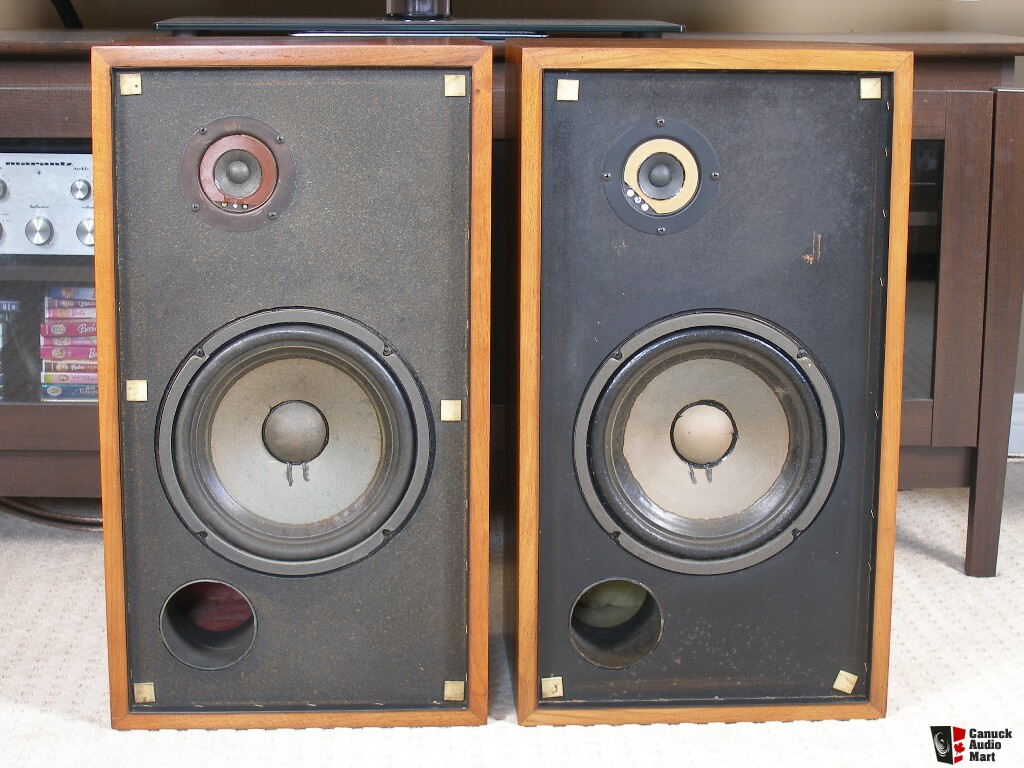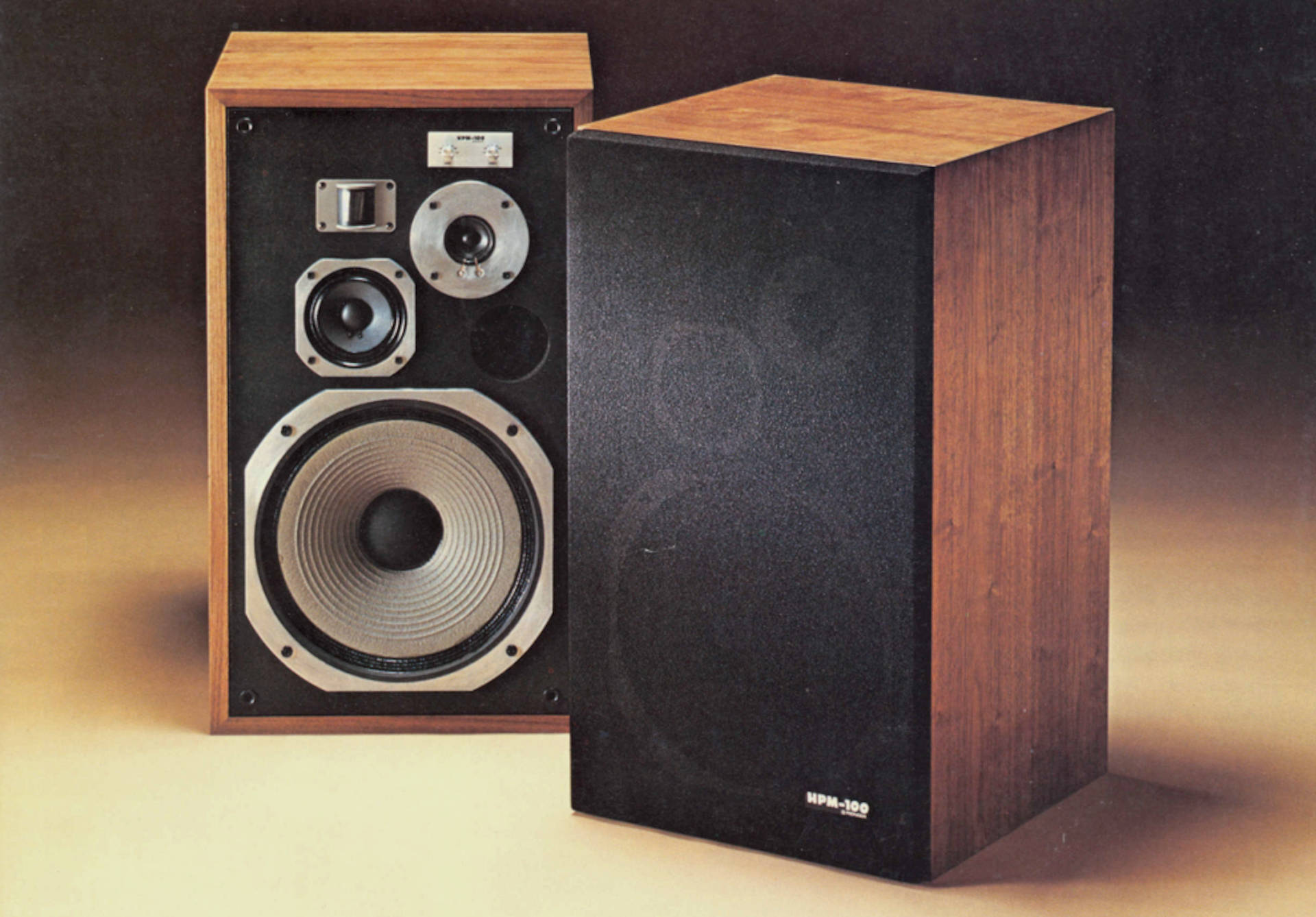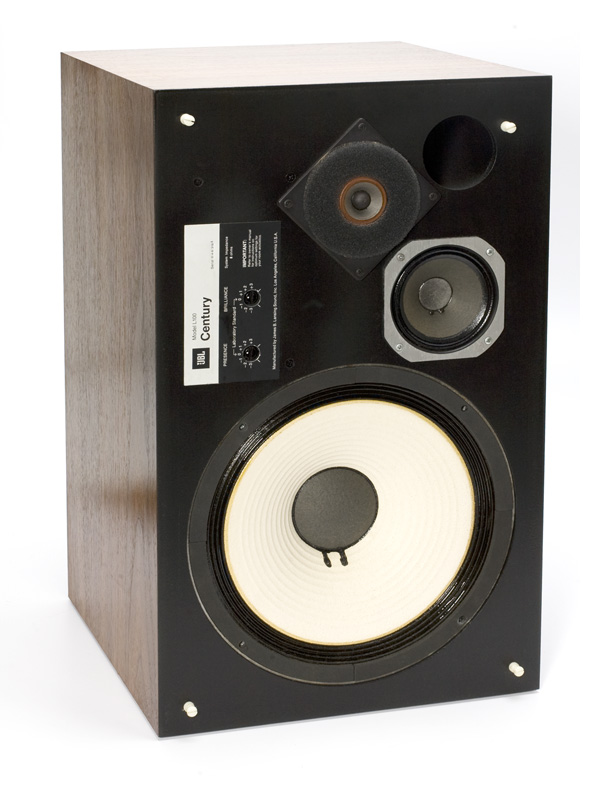- Joined
- Jan 15, 2020
- Messages
- 6,871
- Likes
- 16,826
Quite interesting German magazine article about the history of JBL which I post electronically translated below, the original source with more photos is https://www.lowbeats.de/75-jahre-jbl-75-jahre-loud-clear/
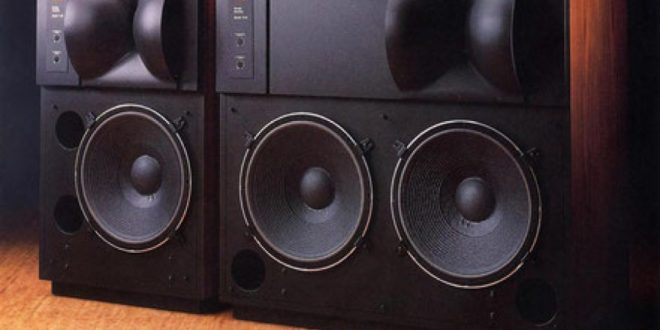
Like no other manufacturer, JBL stands for the combination of hi-fi and studio - here the studio monitors 4430 and 4435. LowBeats took a look at 75 years of company and loudspeaker history (Photo: JBL)
75 years of JBL: In October 1946, a certain James B. Lansing laid the foundation for a loudspeaker brand that bore only his initials without any glamour. Today, JBL is the largest and best-known speaker brand in the world. LowBeats took an intense, by no means brief, look back...
When James (aka Jim) Bullough Lansing was born on January 14, 1902 in Green Ridge, Illinois, he was not only the ninth child in the family, he also bore the family's name: Martini. It had nothing to do with vermouth (see Martini ) but rather with melancholy – here in the sense of sadness. There was next to nothing there and what was there quickly disappeared. That, too, is America: the boy was born in a backwater town that had existed for little more than 30 years at the time, and which presumably only had the “Green” in its name because the shacks in which the villagers lived were painted green. The people of "Green Ridge" lived off and around a coal mine, which James' father also bent over backwards for.
Big family, meager wages, lots of hunger. This may also explain a little why the ninth offspring (of a total of fourteen siblings) stayed in Litchfield, Illinois with a foster family named "Bullough" (meaning: bull/ox). The pubescent boy must have felt so comfortable in her care that years later he took her name. The fact that he then also gave himself the surname "Lansing" is more due to a fad of the early 20th century in the United States. His name was simply meant to sound "American" and not like his ancestors, Italian immigrants. It didn't do him any harm. Two of his brothers (Bill and George) made it easier for themselves and simply dropped the -i from the surname and were henceforth called Martin.
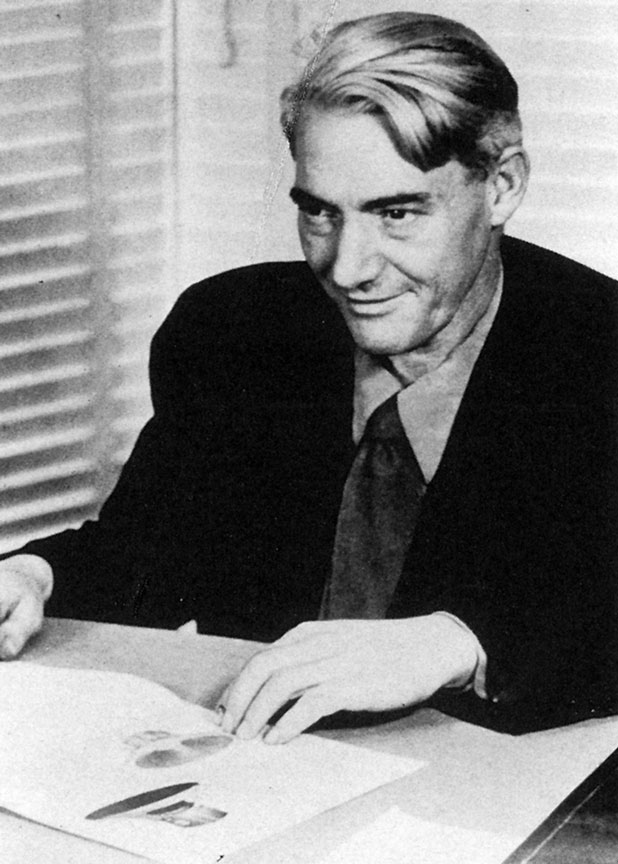
It is probably the most well-known image of James B. Lansing, who founded today's largest and best-known loudspeaker brand. However, the company did not bring him any blessings (Photo: JBL)
There is no doubt that Jim grew up in a time of technological breakthrough. The telephone, the radio, the automobile became mass products in the United States in the 1910s and 1920s. James' home state, Illinois, also came into focus, because that's where the Lincoln Highway was built from 1913, connecting the east and west coasts and leading through 13 states.
So it's no wonder the boy was infected by the "technology virus". Around the age of 12, he is said to have built a crystal radio receiver and transmitter powerful enough to jam naval communications. Didn't find it that great, because it was located and the transmitter shut down. However, this did not dampen his enthusiasm for technology. James graduated from high school, found a job at the Leland Lincoln dealership in Springfield. People there were very satisfied with him, recognized his talent and paid for attending a car locksmith school in Detroit. It was a time when spare parts for cars were hard to come by, so Jim learned the skills of making parts himself, John Eargle also reports in the book"The JBL History: 60 Years of Audio Innovation ". When James' mother died unexpectedly on November 1, 1924, he decided to go west.
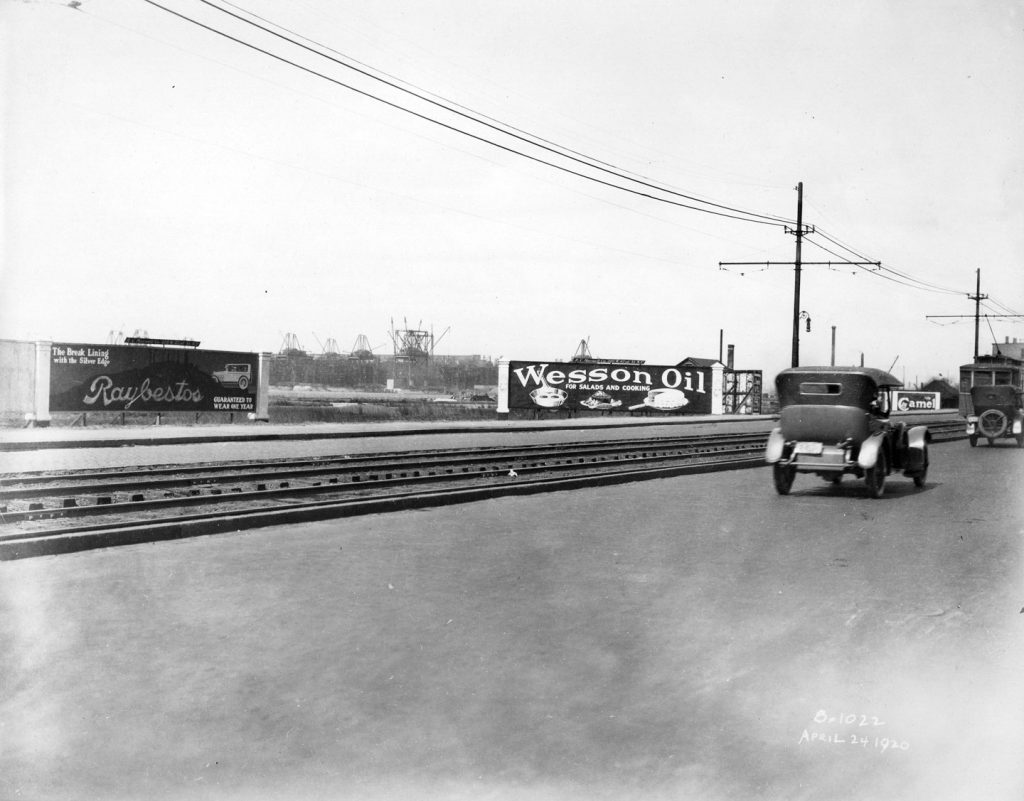
Jim Lansings grew up in a time of technological breakthrough. For example, the first highway in the USA – the Lincoln Highway – crossed his home state of Illinois. The picture shows the Lincoln Highway in the 1920s (Photo: Wikipedia)
No sooner said than done, he landed in Salt Lake City. He was young, he was certainly bubbling with ideas and found a job at the "Felt Auto Parts Company" - a suitable new start to prove and expand his knowledge of automotive and mechanical engineering. You don't have to read between the lines: Jim wasn't a qualified electrical engineer like Paul Wilbur Klipsch and - here an "unfortunately" belongs - also not a resourceful businessman like Frederick Whitney Horn , but a fascinating, talented inventor and autodidact, as we shall find out.
In 1925 James not only met his future wife, Glenna Peterson, but also Kenneth Decker. James had meanwhile decided to get into the manufacture of loudspeaker chassis and was looking for a partner. Decker, whose family ran a thriving jewelry business, was probably also drawn to the idea, as the two teamed up. Finally, in 1927, they moved to Los Angeles, then the center of radio receiver production. At home they made loudspeakers from folded paper cones and self-wound voice coils. In the same year, Born Martini, he changed his name to James Bullough Lansing and founded the Lansing Manufacturing Company (LMC).
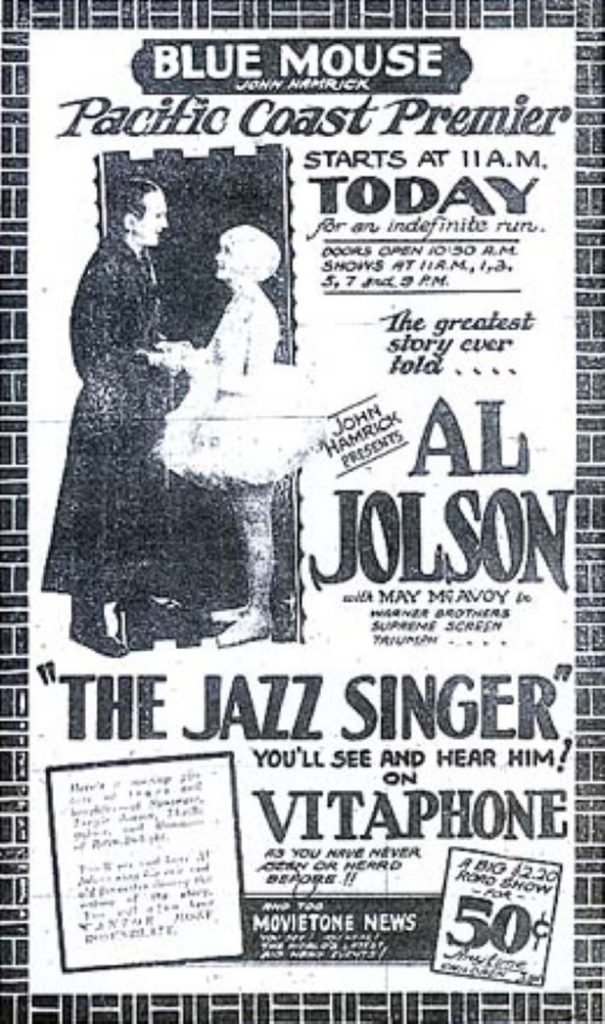
"The Jazz Singer" is considered the first commercial sound film. It was released in cinemas in 1927 and the audience was enthusiastic, the triumph of the sound film unstoppable. And yet there were problems, because the sound quality was not really convincing. This was not only due to the lack of powerful technology, but also to the fact that some of the cinemas were huge at the time: they sometimes held 5,000 spectators (Photo: Wikipedia)
Another event that attracted worldwide attention in 1927 was to determine the later future of Lansing's company: in October the first sound film - " The Jazz Singer " - was released and the audience was enthusiastic. Although the sound reproduction was far from perfect. In fact, the film industry itself did not have its own loudspeaker production capabilities, so Western Electric (WE), a telecommunications industry company (AT&T), took over the part. There was sound for the moving image, but there was no question of "sound". The early WE cinema loudspeakers consisted of a large curved exponential horn, whose frequency response was limited to the range from about 100 Hz to 5000 Hz. Even adding tweeters and woofers was not enough to convince the filmmakers in Hollywood.
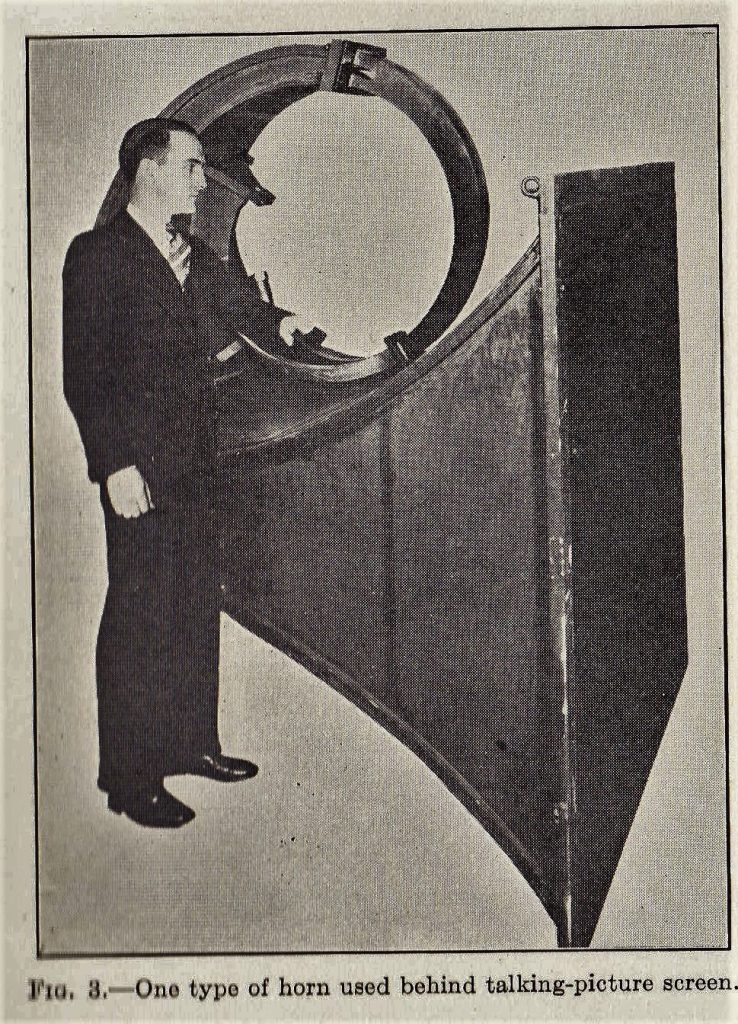
Western Electric's WE 15A. Year of manufacture probably 1927
Things got better in 1933. Douglas Shearer, head of the MGM sound department (MGM: Metro-Goldwyn-Mayer, film production), decided to take the development of new loudspeakers into his own hands and to seek external support for this. Lansing and Decker were already producing chassis for cathedral radios with great success, which integrated the loudspeaker into the housing. They had meanwhile reached considerable quantities, supplied a wide range of manufacturers of radio receivers and employed 40 people. A size that was apparently enough to draw attention to itself. Speaking of size: anyone who thinks of today's usual halls with just over 300 seats when hearing the term "cinema" is more than ten times wrong. At that time, a movie theater in the USA could hold 5,000 spectators – mind you, in one hall. And it was quite common back then to go to the cinema twice a week! Nice old pre-television days.
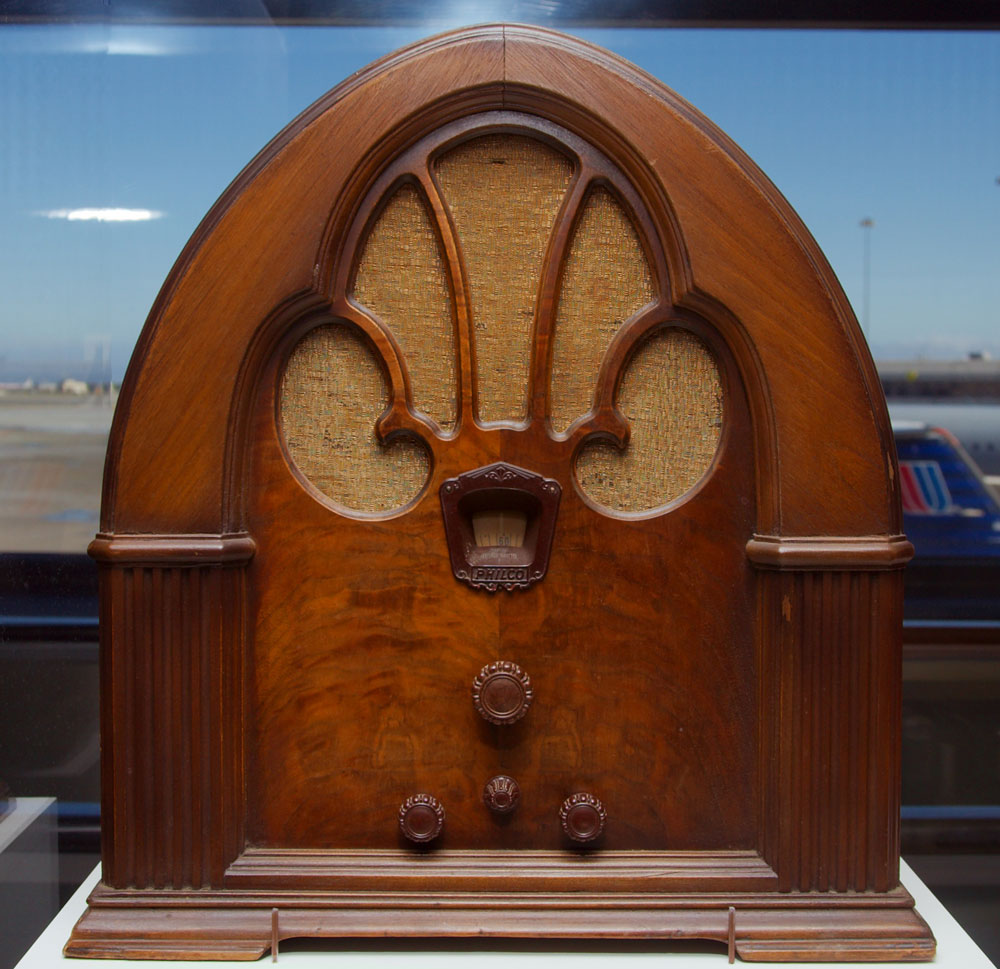
One of those cathedral radios for which Lansing & Ceiling made speakers at the time: here a model from the "Philco" brand from around 1930. It seems like a historical joke that almost 100 years later JBL is again having huge success with single-box devices … (Photo: HiFi Wiki)
Lansing finally got the order to develop cinema loudspeakers together with MGM. The so-called Shearer-Lansing system was implemented within two years . It was a large two-way system consisting of a multi-cell tweeter horn and a W-shaped woofer horn enclosure. After a successful test run in twelve of MGM's own Loews cinemas, 150 units were ordered and installed. A smaller model also came onto the market, the 500-A. It was used for sound reinforcement in projection rooms and dubbing studios - early studio loudspeakers. A segment in which the company, later renamed “JBL”, will also occupy a leading position for many years.
In 1937 Lansing developed the Iconic system. It's a small two-way system with a vented 15-inch woofer and a small-size compression tweeter driving a small multi-cell horn. Frequency response: 30 to 15,000 Hz! No wonder the Iconic system became the most popular monitor speaker of its time and served as the foundation for studio speakers to follow.
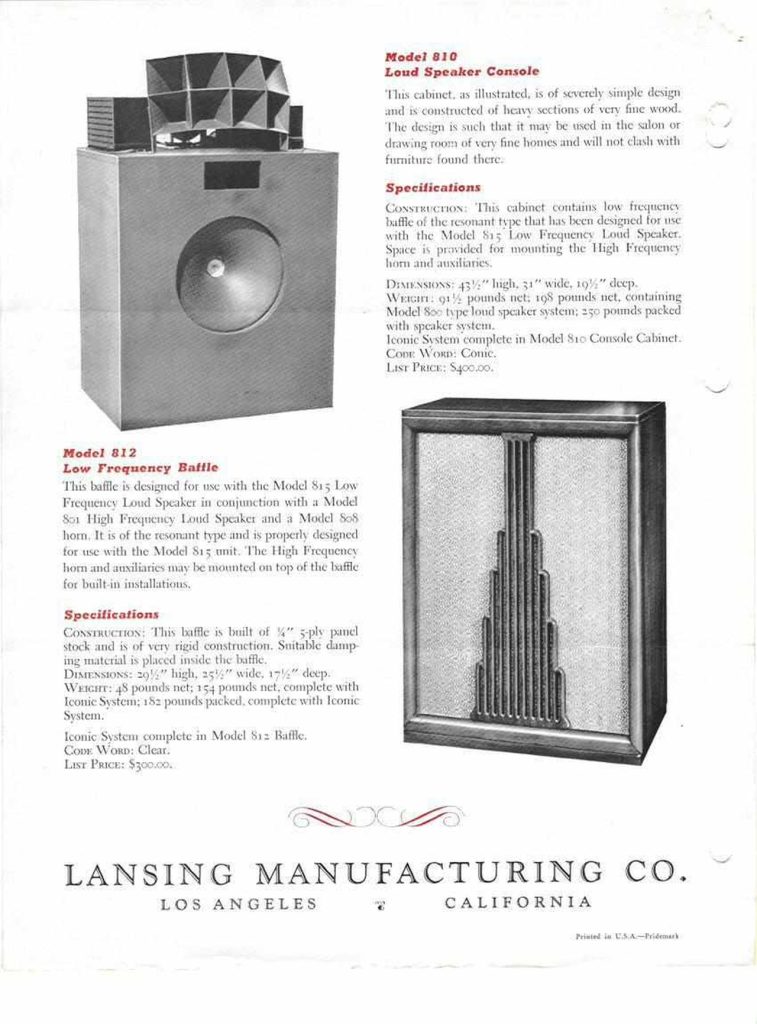
It still looks delicious today: The Iconic System already achieved a really high-fidelity frequency response: 30 – 15,000 Hz (Photo: JBL)
LMC also used the great success of the Shearer-MGM connection in other product areas. The company continued to supply systems for the motion picture industry and a variety of early professional sound reinforcement applications. However, the company's success depended on the synergy of its key players - Ken Decker and James Jansing. When Decker died during US Army Air Corps maneuvers in 1939, not only did Lansing's partner die, but also the company's chief financial officer. Already at the beginning of 1941 the consequences are clearly noticeable. Only nineteen employees are still actively working for Lansing Manufacturing Company at this time.
Ultimately, cinemas were probably not enough as the main segment for sales, and the manufacture of loudspeakers for radios was not seriously pursued. Decker could have opened up new markets if he should... A similar fate happened to Altec Service Corporation (Altec is an acronym from the words "All Technical"), a company that specialized in the maintenance of Western Electric sound equipment and the the spare parts ran out because WE had withdrawn from this segment. John Kenneth Hilliard, a senior sound engineer at MGM and instrumental in the development of the Shearer-Lansing system, eventually suggested that the company heads meet. The goal: to be more efficient and competitive together. As a result, Altec Service Corporation purchased Lansing Manufacturing Corporation on December 4, 1941 for $50,000 (equivalent to around $1 million in 2021). Jim Lansing signed a five-year contract with the new company and was named vice president of engineering. The "Altec Lansing Corporation" was formed.
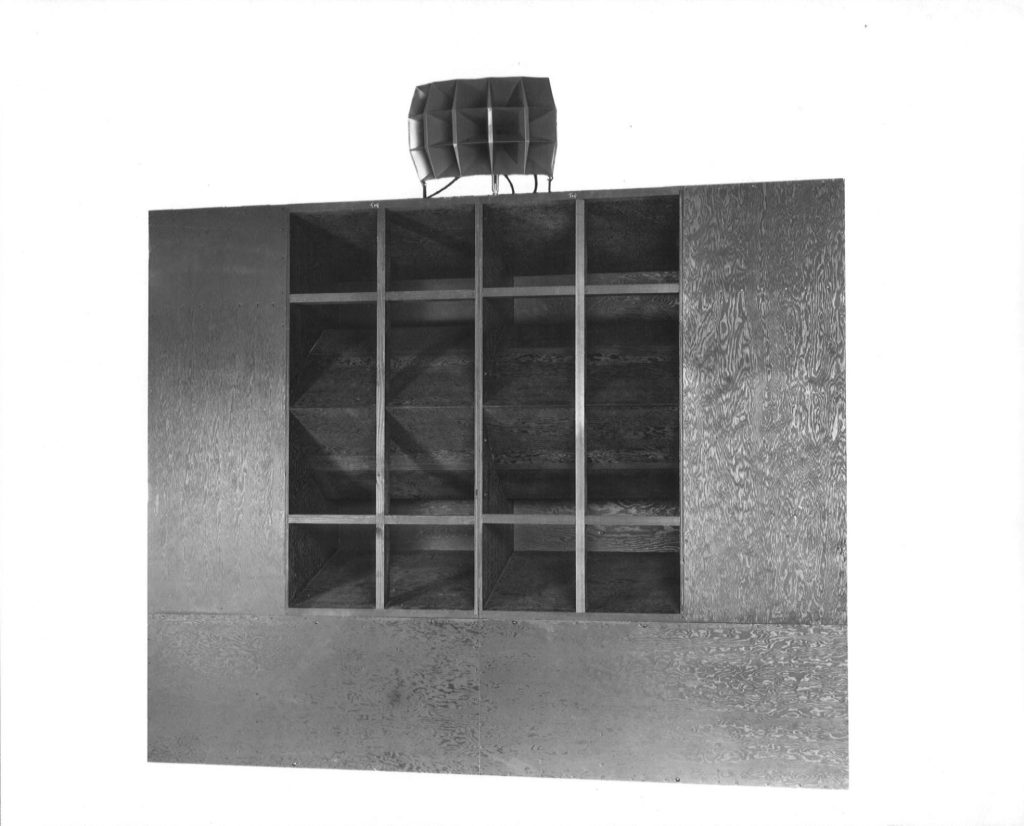
For the first time, the Shearer Lansing system brought good sound to the back row of cinemas. It was released in 1935 and installed in MGM's "Loews" movie theaters. The two-way system consisted of a multi-cell tweeter and a W-shaped woofer horn housing (Photo: JBL)
Three days after the ALC was founded, Pearl Harbor was attacked, with consequences for the whole country, including Altec Lansing. Products important to the war had priority. The American President Roosevelt demanded the uninterrupted production of armaments. Later, US citizens were even called upon to donate all their copper, aluminum and other materials as war donations. Altec Lansing supplied the government with transformers and other electrical equipment. The research on new speaker chassis, however, continued uninterrupted, because business was good despite everything.
The cooperation with the military was also to bear unexpected fruit: in 1943 Altec Lansing was commissioned to work on a radar project for military aircraft. This gave James Lansing access to a new type of magnetic material - AlNiCo.
AlNiCo was a quantum leap for driver construction, it was to revolutionize speaker construction and dominate for decades. Using AlNiCo V, Jim Lansing developed a new version of a large format permanent magnet compression driver . He also perfected the hydraulic forming of aluminum cones and the voice coils were wound from aluminum wire using a new process. The result was the Altec Lansing 288, which was to remain in the range for decades in all its evolutionary stages.
Although financially successful, Jim Lansing only stayed with Altec Lansing Corporation for five years. "I'm just a name for them," he is said to have said and left the company after his contract expired - allegedly to grow avocados and lemons. However, anyone who thought Lansing would have been content with that had dealt in lemons themselves. Lansing Sound Incorporated was entered in the commercial register on October 1, 1946. This naming annoyed Altec Lansing, and shortly thereafter Lansing renamed the company James B. Lansing Sound Incorporated, or JBL for short.
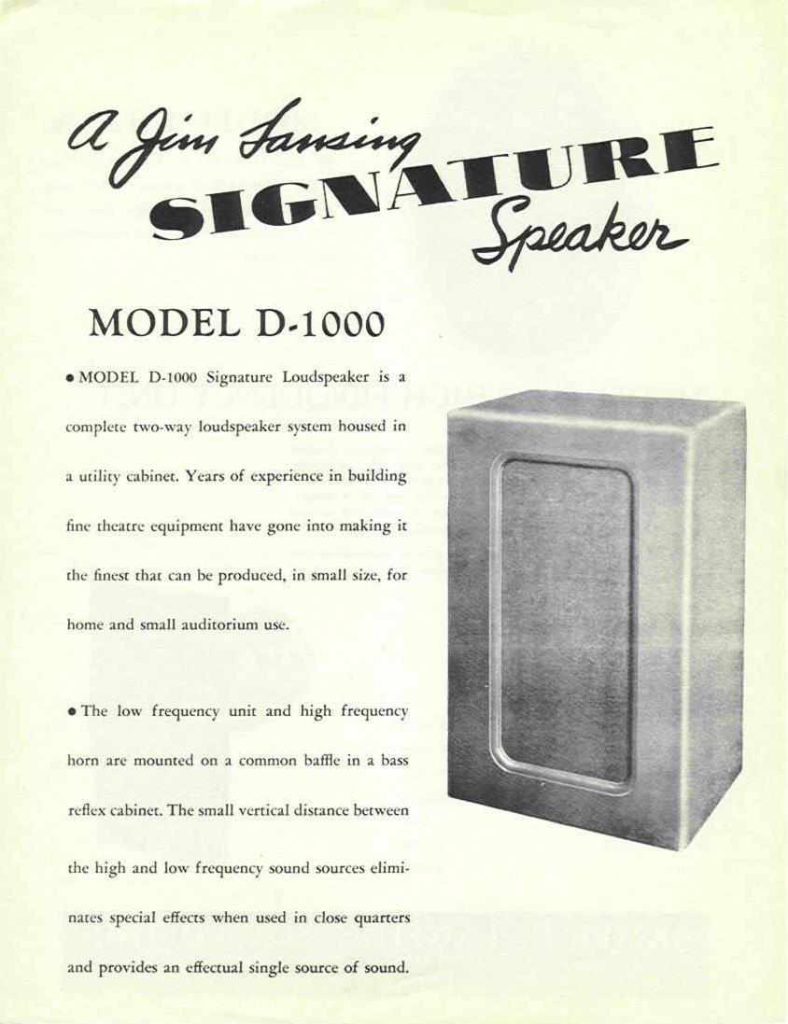
Jim Lansing's first speaker for the music lover at home appeared in 1948, the D-1000, a two-way bass reflex system. It is advertised with the following words: "The D-1000 Signature loudspeaker is a complete two-way loudspeaker system housed in a practical housing (Photo: JBL)
Demand grew, JBL had to grow, production was bursting at the seams. This is where William Thomas from Marquardt Aviation came into play for the first time. He agreed with Lansing on a share of ten percent of the net sales, for which Lansing provided him with production facilities and employees. Marquardt manufactured engines for the United States Army Air Forces, so there was no end to the space. And money. Money that Lansing could use for its production.
Unfortunately, that didn't help much either. Because while Marquardt Aviation grew, Lansing got more and more indebted. In desperation, he tried to sell the company to Roy Marquardt, but he didn't put much stock in loudspeaker manufacture. Finally, Marquardt Aviation was taken over, but the buyer was also not interested in the James B. Lansing Sound. In the end, Lansing only held 30 percent of the company because of his debt. Roy Marquardt decided that William Thomas should run the company. Although the bright developer spirit had always given everything, he probably lacked the strength for a new beginning. James Bullough Lansing took his own life on September 29, 1949. He was only 47 years old.
This was no coincidence, as William had long been working on the soundproofing of aircraft engines and enjoyed researching acoustics. His commercial experience, which poor Lansing repeatedly failed, was undoubtedly helpful. So William Thomas quickly drew up a three-year plan to reduce operating costs while increasing sales. Through aggressive marketing and streamlining of production, he achieved this by the target year, and annual sales climbed from $60,000 to $200,000 in 1952. Profits were meager, but William Thomas had new ideas long ago.
He recognized the growing need for hi-fi loudspeakers and concentrated the offer on this segment. His goal: to establish JBL as the outstanding hi-fi brand. To do this, the bride had to be prettied up, which means that the products shouldn't look like household appliances or do-it-yourself products, but stylish. In 1950, William Thomas hired the industrial designer Alvin Lustig for this purpose. merry knew that aesthetics could influence the purchase decision just as much as technical quality. Connoisseurs certainly think of the German hi-fi company BRAUN, which also successfully implemented this concept from 1956. Works by Alvin Lustig are the C34 , C35 Fairfield , C36 Viscount , C37 Rhodes ,C38 Baron and the C40 Harkness . Boxes that are still extremely popular among collectors today.
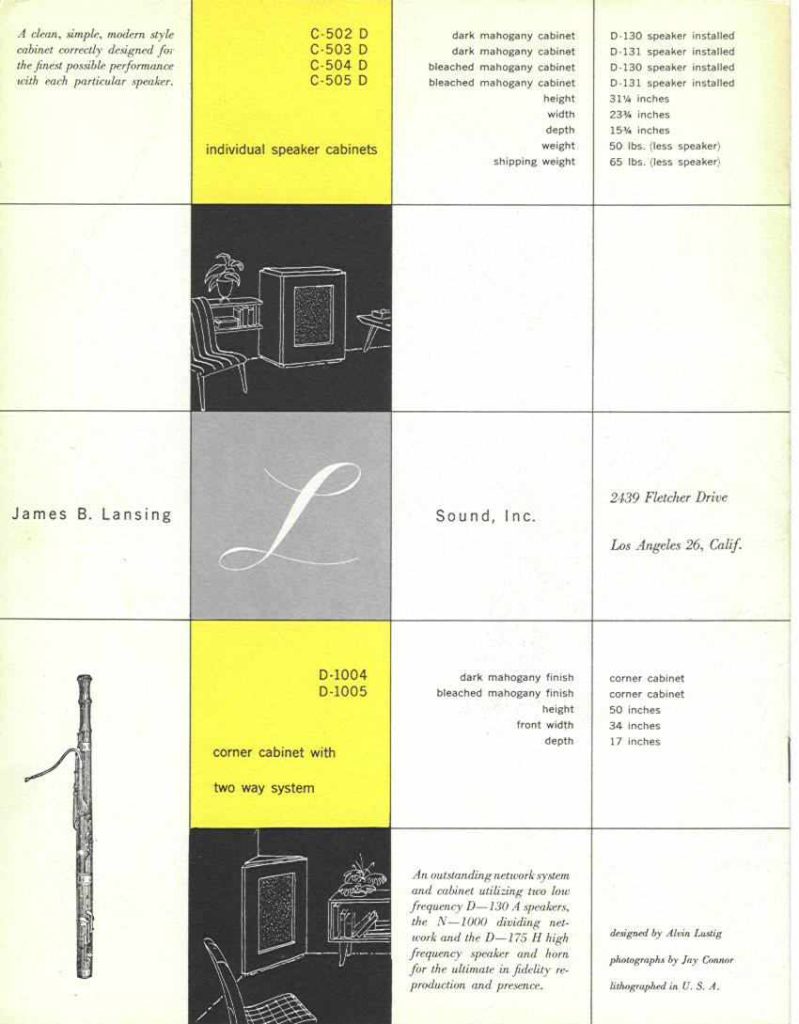
At the beginning of the 1950s, the new owner of JBL, William Thomas, focused on design for the first time. He has the well-known industrial designer Alvin Lustig create a product catalog for chassis and boxes. He also entrusts the design of housings to Lustig (Photo: JBL)
Now you have to have a very special taste to locate The Hartsfield as a "design box". It was the JBL alternative to Paul Klipsch's Klipschorn. And unlike the Klipschorn, which still exists today, the JBL was a 2-way construction - which in the case of a corner horn is only the second best idea in terms of sound. The Klipschorn still exists today (version VI), The Hartsfield is only highly valued by collectors...
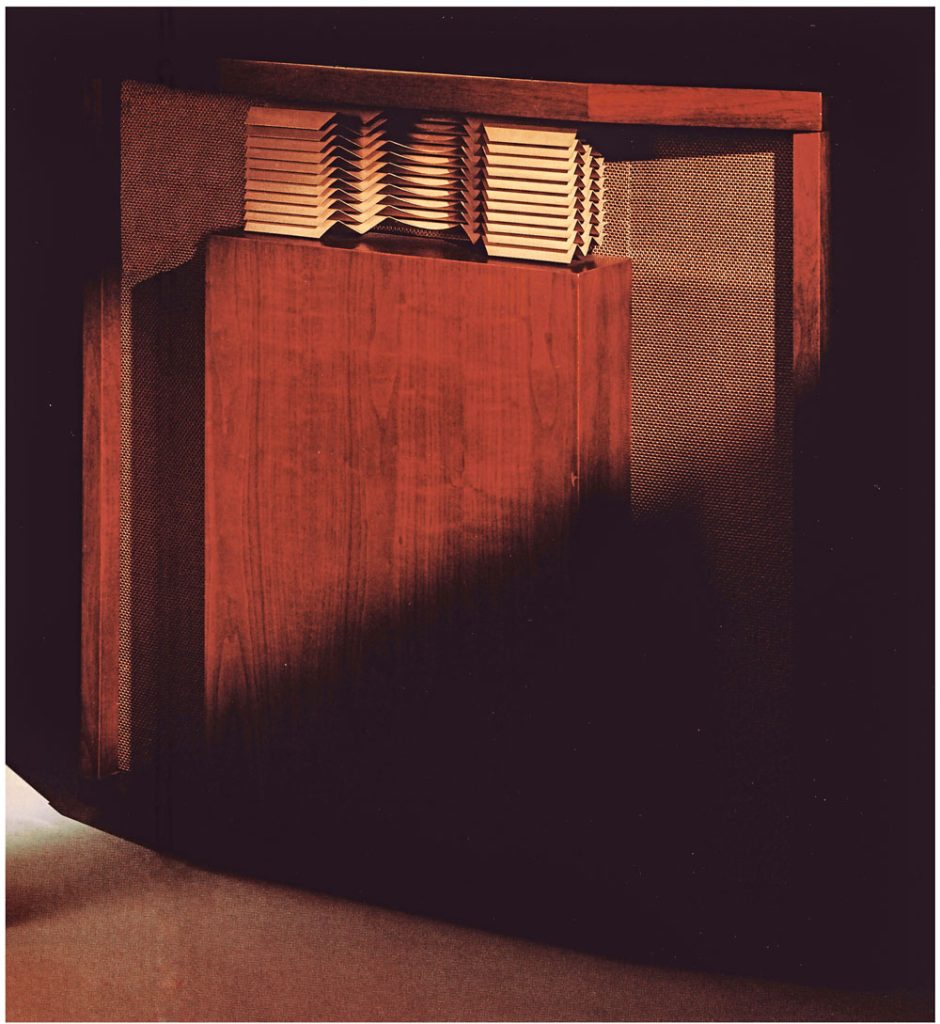
1954 JBL's Hartsfield comes onto the market. A corner horn that is more than clearly inspired by the Klipschorn, but is considered an independent construction due to the technically superior drivers (Photo: JBL)
And so the gap that James Lansing left as a genius designer became more and more obvious. Although William Thomas also took on some engineering tasks, he did not match Lansing's creative power. So Thomas brought the developer Bart Nicholas Locanthi into the team. A graduate of the California Institute of Science, Locanthi earned an excellent reputation in the audio industry well into the 1980s. For example, Locanthi designed the 1217-1290 horn for JBL's 175 driver, which is believed to be the first commercial example of this type of radiator. A development that formed the core technology for JBL horn products over the next 30 years.
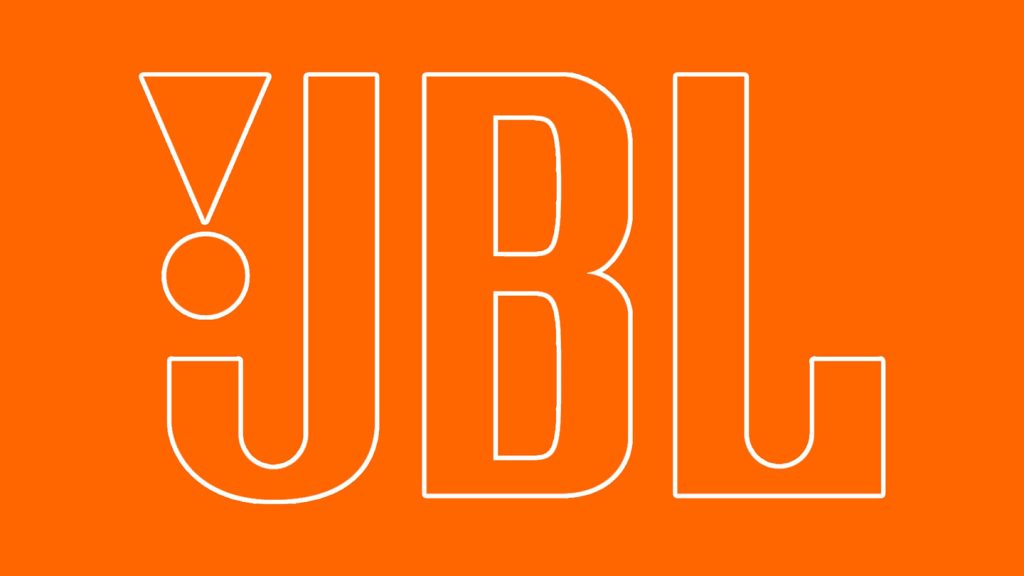
By 1955, William Thomas had finally managed to increase JBL's sales to $1 million. In the same year, the JBL initials were introduced as a logo for the first time. (Photo: JBL)
JBL took another big step in 1957 when the stereo record appeared. William Thomas wanted to achieve supremacy in home audio with a loudspeaker milestone. This is how the Paragon D44000 came about ( here is a small impression from the Youtube world) and the plan worked. The 340 kg Paragon - a full-fledged three-way horn with a real bass horn and pressure chamber drivers for the middle and high frequency range - remained in the program for 26 years. It was displayed and admired at international exhibitions such as the Expo 1958 in Brussels and was readily bought by the rich and famous. At the time, only they could afford it. The Paragon cost $1830 in its introductory year, which equates to about $18,000 in 2021. In total, JBL probably produced around 1000 copies by 1983. In terms of marketing, the Paragon was a mega success, and despite the high price, it was hardly worth it for JBL financially.
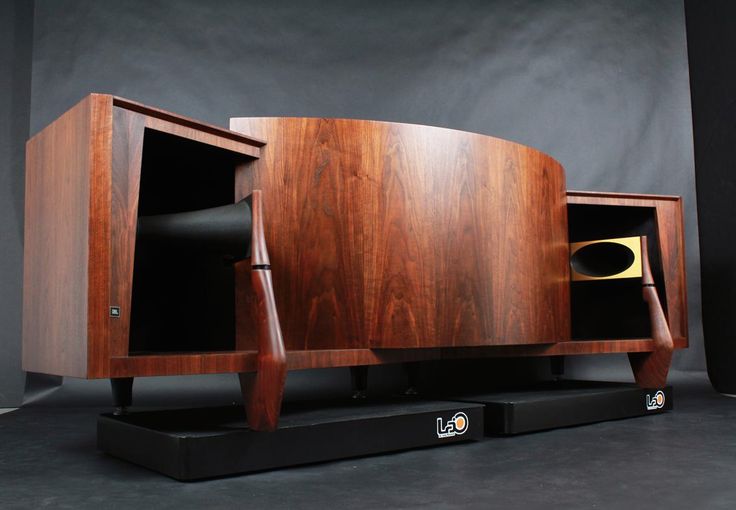
In 1957, JBL surprised everyone with the Paragon, a full-blown three-way horn weighing 340 kg (sic!) with a real bass horn and pressure chamber drivers for the midrange and high-frequency range in just one housing. The elegant case design of the JBL Paragon still enchants today...
At the beginning of the 1960s, it also became apparent that large loudspeakers would be less in demand in the home. The expansive music furniture soon gave way to smaller and medium-sized systems that still had good bass reproduction. The traditional Lansing drivers worked best in large enclosures, and their high efficiency was perfect in the days when amplifiers could hardly exceed 30 watts. The hi-fi industry had caught up, higher power amplifiers that took up less space prompted the development of a new generation of cone loudspeakers. Up until 1963, under Bart Locanthi's direction, new drivers of the so-called " Linear Efficiency " were created” series, abbreviated as “LE”. They stood for high linearity at high levels. With the new drivers, compact floorstanding and shelf speakers were now possible.
Parallel to its commitment to the hi-fi sector, JBL has always stepped on the gas in the professional segment. Leo Fender, the legendary manufacturer of musical equipment, relied on the D130 for its guitar amplifiers with built-in speakers .
A Closer Look at the D130: JBL's D130 was a stand-alone loudspeaker that the company began producing in 1948. Although there have been numerous revisions and updates, it is still part of the range today and carries the model designation E130 . An E130 is not a lightweight, it weighs ten kilograms. The D130 was originally designed as a pure woofer, but with the expansion of the frequency range it also became very popular as a mid-woofer.
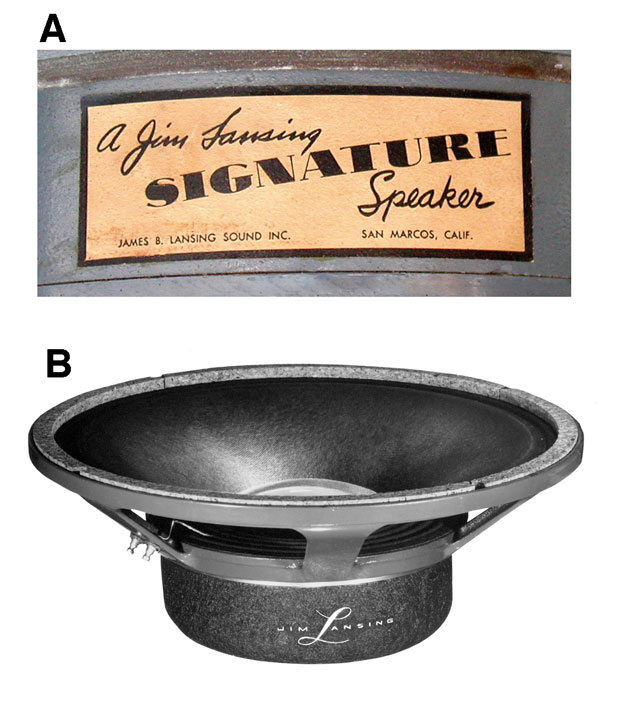
The D130 was one of the first loudspeakers to feature an aluminum dust cap - as opposed to the fabric dust caps found on its competitors. A cast aluminum frame on the D 130 supports the 15-inch cone, and a rubber seal surrounds the rim to prevent dust from entering the voice coil (Photo: JBL)
The voice coil of the D130 was another innovation: it was 4 inches wide, and while that size is common today, it was revolutionary at the time. Lansing used a flat metal ribbon instead of a wound fine wire to create a coil with a size-to-performance ratio never seen before. The design made more efficient use of the natural shape of the magnetic field, allowing more power to be generated with less material. This design also dissipated heat and energy more evenly, reducing the risk of breakage and increasing cone life.
Although JBL manufactured the D130 largely unchanged throughout its production history, an alternative version was produced specifically for use in guitar amps. The speaker was designated the D130F and was specially made at Leo Fender's request. The D130F was identical to the D130 but had a 12 inch cone instead of the usual 15 inch.
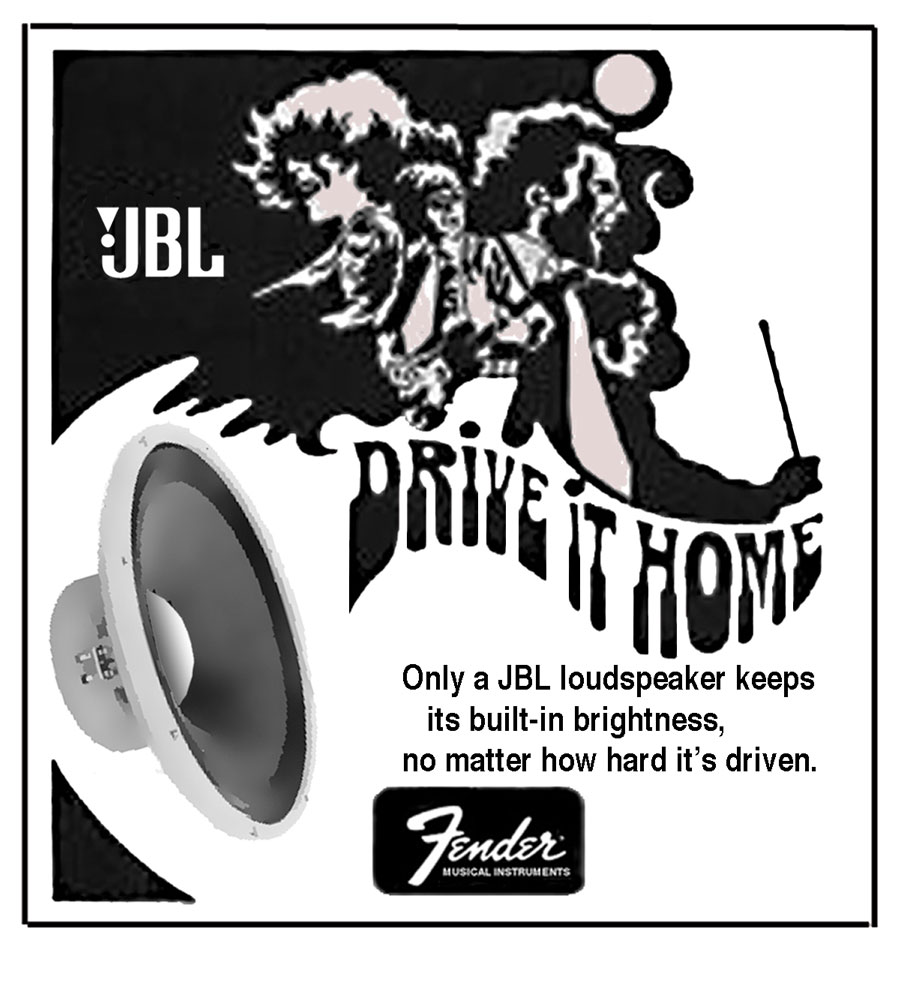
The guitar specialist Fender also quickly understood that the basses from JBL were simply better than those of the competition (Photo: JBL)
The professional market remained a constant at JBL, not only for the stage, but also for mixing as monitor loudspeakers in the recording studio. JBL was therefore always keen to engage in dialogue with music creators, so it is not surprising that one of JBL's most famous loudspeakers, at the suggestion of the then well-known sound engineer Bob Finewas born – the 4310 monitor. Fine required eight compact loudspeakers for the new eight-track recording process, which he wanted to place in the control room above the window to the recording room. All the boxes he had available were too big, he turned to JBL and the 4310 soon became the de facto standard for near-field monitoring - even if playback with one speaker per track turned out to be impractical. We will encounter the 4310 and its derivatives again.
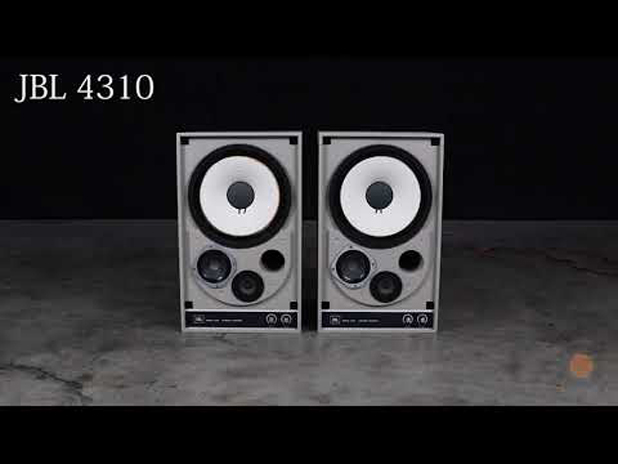
The JBL 4310 was developed for the studio, but also enjoyed a high reputation among ambitious hi-fi fans (Photo: JBL)
For those who enjoy the original, by the way: Kenrick-Sound , based in Tokyo/Japan, has specialized in loudspeakers from the 4310 series and later from JBL. Restored and modified chassis are used in historical as well as in newly built boxes. However, saving is advisable: The systems are sold for up to 30,000 euros and more without any problems.
In 1969 the William Thomas era came to an end. Under his leadership, JBL had blossomed into a globally recognized loudspeaker manufacturer in the domestic as well as in the professional segment. In the same year, the legendary Woodstock Festival only used drivers from Altec-Lansing and JBL . A belated tribute to the incredible work of James Bullough Lansing and the companies that grew out of it. He would have liked it. Certainly also the results that JBL achieved: When William Thomas handed over to Sidney Harman in 1969, he had increased annual sales to around nine million dollars - today (2021) that would be the equivalent of around 68 million US dollars.
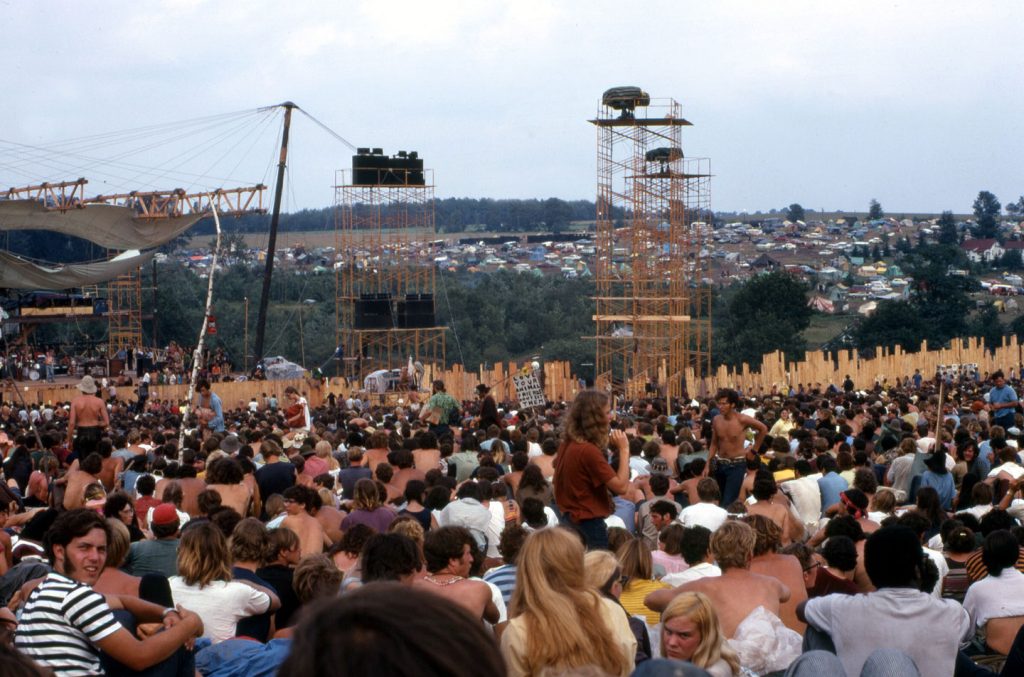
It wasn't just the sound that moved the world: The 1969 Woodstock Festival was professionally equipped with JBL and took place on the pastures of a dairy farmer near Bethel in New York State (Photo: Wikipedia)
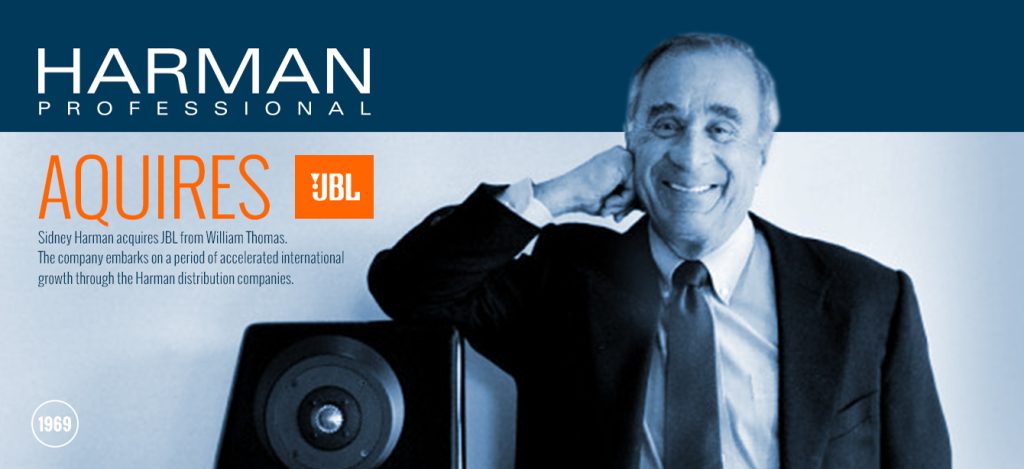
1969 JBL is taken over by Sidney Harman. With a two-year break, he will lead the company to further major successes until 2007. Incidentally, he is leaning casually here on a 250Ti (Photo: JBL)
The native Canadian not only knew about electronics, but was also a clever marketing strategist. One of his first official acts: to introduce the gratifyingly successful 4310 studio monitors as the L100 in the home audio sector. Harman pressed the tube: The JBL L100 Century was already presented at the CES 1970 in Chicago. The 4310 and L100 were technically almost the same, which JBL didn't even try to hide, they boasted about the numerous uses of the boxes in the recording studio. JBL used a single sentence as a message to market the speakers: "You can hear music in your home the way the sound engineers heard it when they created it." The box sold like hot cakes.
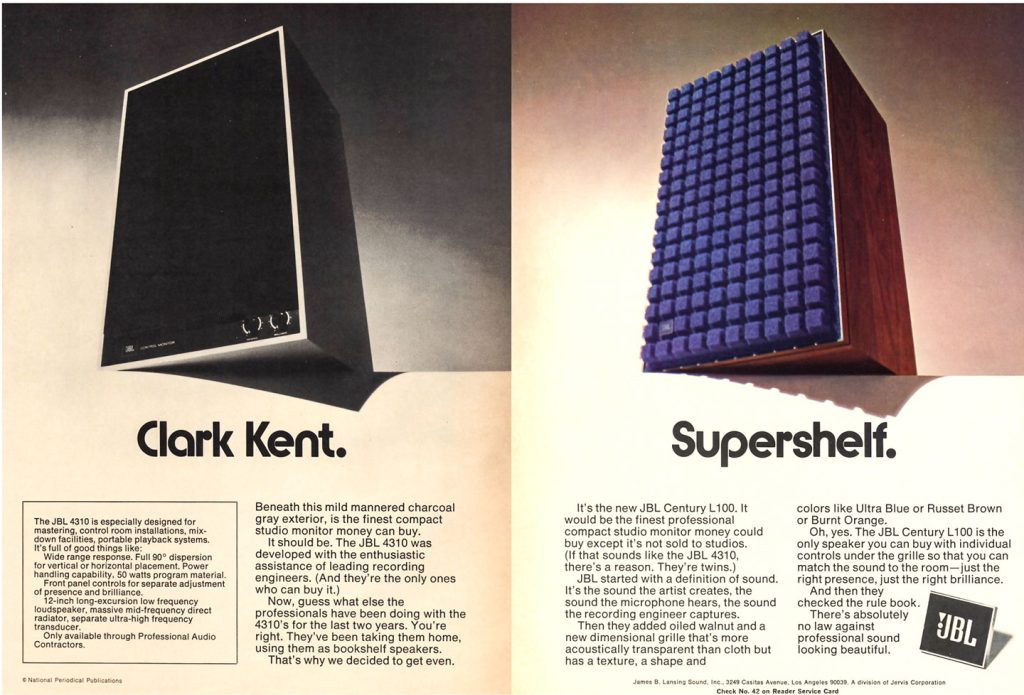
One of Sidney Harman's first decisions quickly turned out to be brilliant: The Box 4310, which was very successful in the professional sector, was marketed in the home segment as the L100 from 1970. The advertising campaign shown is a reference to Clark Kent aka Superman. Matching the pop culture of the 1960s and 1970s, the colors of the speaker covers on the L100 were also available (Photo: JBL)
The original L100s weren't just JBL's best-selling hi-fi speakers of those years. "There's also evidence that this product was actually the best-selling speaker system of the decade," said Jim Garrett , Senior Director, Product Strategy and Planning, Luxury Audio at Harman on JBL's 75th Anniversary (2021). Because of the resounding success, Harman introduced the cheaper L200 and L300 models in the hi-fi sector, while the 4320 and 4333 models became larger and more expensive in the professional segment.
But there have also been setbacks. At the end of the 1970s, the global supply of cobalt almost came to a standstill. Suddenly it was hardly possible to produce AlNiCo V anymore. While there were replacements on the market in the form of ferrite magnets, these could not readily be used with JBL's existing speaker models.
As a result, new drivers had to be developed, which also led to new products. But this is where the enormous knowledge in the development department showed itself: Although today only very few drivers are equipped with the (soundingly superior) AlNiCo magnets, the woofers, mid-range drivers and tweeters from JBL are still considered towering by many other brands think. Especially in terms of level stability and low distortion, there is hardly anything better today. The motto "Loud & Clear" is based on this high understanding of driver technology.
And that also happened within 75 years of JBL: In 1977, Sidney Harman sold JBL to "Beatrice", a conglomerate that also traded in food. The reason was that Harman accepted an office in the Carter administration and was required by law to divest himself of company shares. In 1979, Sidney Harman resigned from government and bought back JBL and other brands. Jack Grigg, long-time Infinity sales manager and Harman Germany CEO, said in an interview: "Originally, he had already sold JBL to Beatrice Foods, who had no idea about electronics. Later he bought JBL back very cheaply. Sidney Harman was a really smart dog.”
A new milestone appears in the Sidney-Harman period in 1982: the L 250, with which he poses in the picture above. With the L series, of which the 250Ti was certainly the most magnificent form, JBL began to think specifically in terms of hi-fi. Because such a half-pyramid shape was of course useless in the studio. The L250 was designed by Greg Timbers who has worked for JBL since 1972. When he started, he was Ed May - who helped to realize the 4310 and the "LE" series - placed aside. He could hardly find a better “teacher”. The L250 and especially the further development with titanium dome - 250Ti - are considered by fans of the brand to be the best loudspeakers that JBL has ever built.
Til today. Doug Warner from Warner Designs was responsible for the design, and he also helped determine the look of the L100. He designed the housing of the bass reflex system as a truncated pyramid with only two vertical side walls. There were countless veneer finishes available, but this was mainly because customers in the US wanted the boxes to match their living room decor. The first version of the L250 featured the LE5 midrange driver and an aluminum-coated phenolic resin dome.
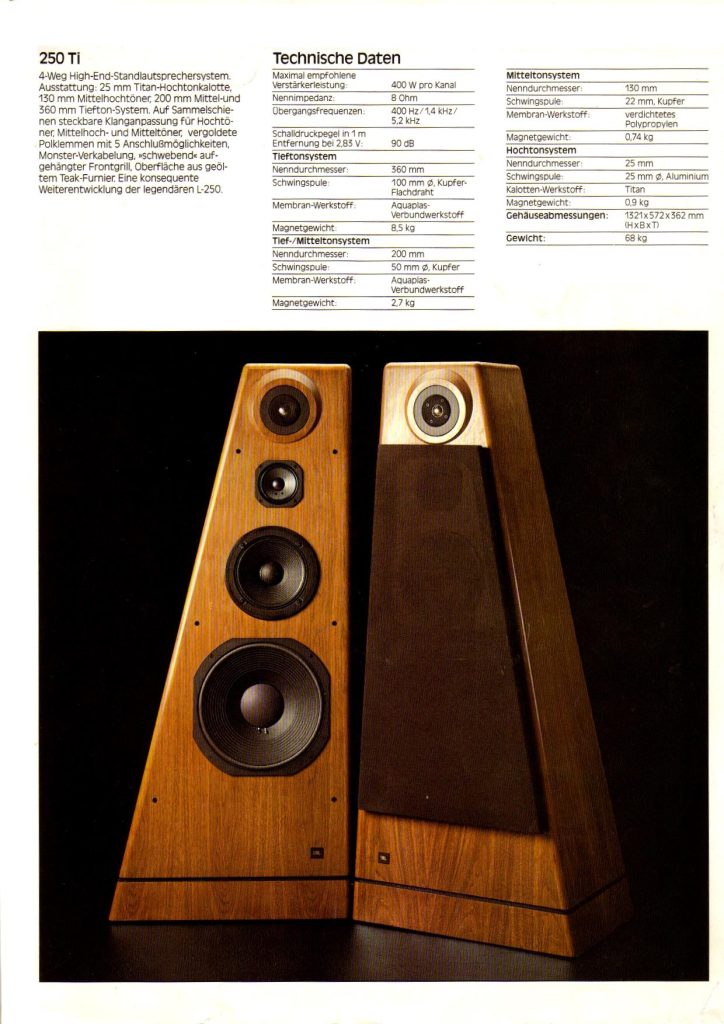
The JBL L250 was a milestone for the brand towards affordable living room hi-fi - but of course with JBL's own dynamics (Photo: JBL)
In Germany, the further improved successor 250Ti (with a titanium tweeter) appeared for the first time in 1985 and was enthusiastically received by music lovers and professional circles alike. Even if their list price of 12,000 DM at the time required some thrift. But the list prices at JBL Germany were soon over, as we will find out later.
In principle, the 1980s were perhaps the most fruitful decade for hi-fi. In addition to the 250Ti, such fascinating models as those of the XPL series or the K2 S-9500 were created - which still exist today in slight modifications
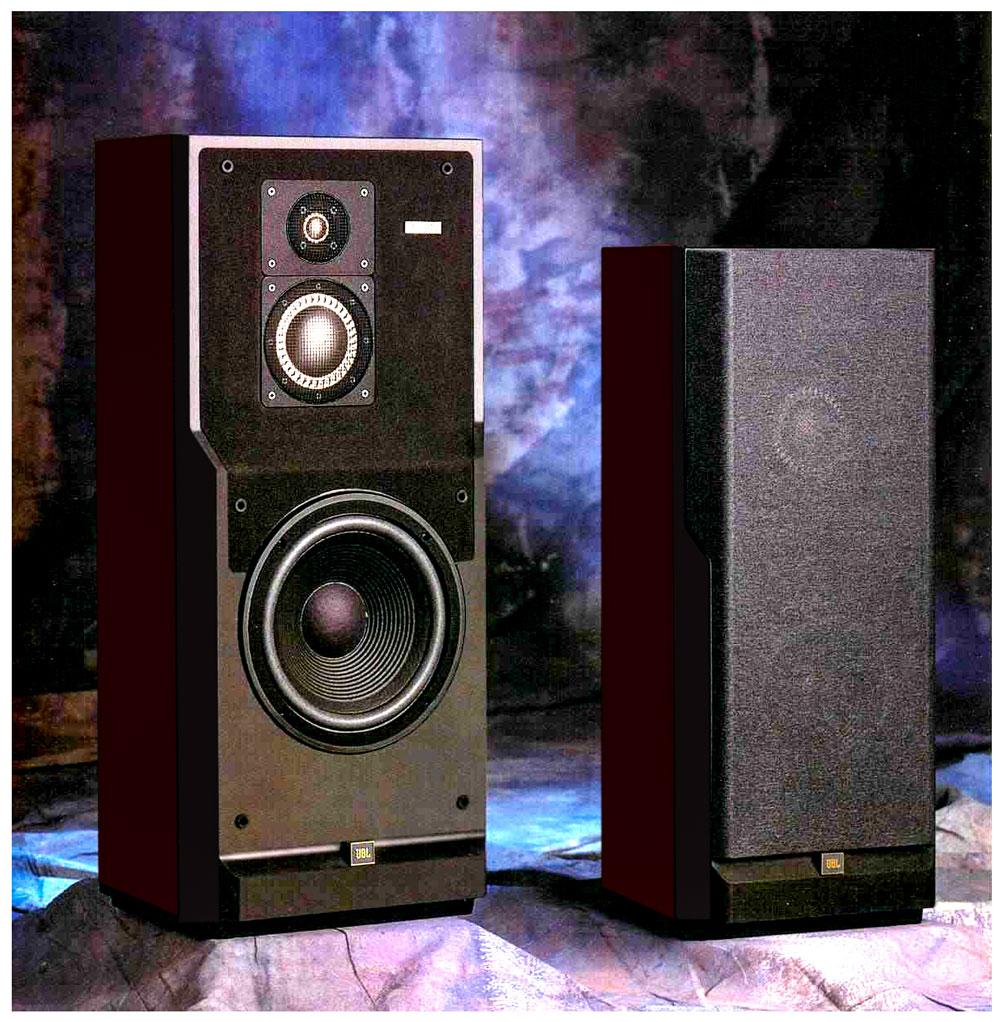
The JBL XPL 160 from 1989. Its special feature was the huge (75 mm) titanium midrange dome (Photo: JBL)
Also in the 1980s (more precisely: 1984) JBL enters a new segment that should turn out to be extremely beneficial in the decades to come. High-quality loudspeakers, cassette radios and amplifiers are supplied ex works for passenger cars. Starting with the equipment for the Lincoln Town Car, a luxury vehicle in the United States. The system was 40 watts more powerful than the competing Bose system in General Motors cars and consisted of a gray JBL car stereo with cassette and two- and three-way JBL speakers. The powerful 6×9 inch woofers in the parcel shelf sported a Ford JBL badge on the metal speaker grille so everyone could tell that the driver cared about good sound.
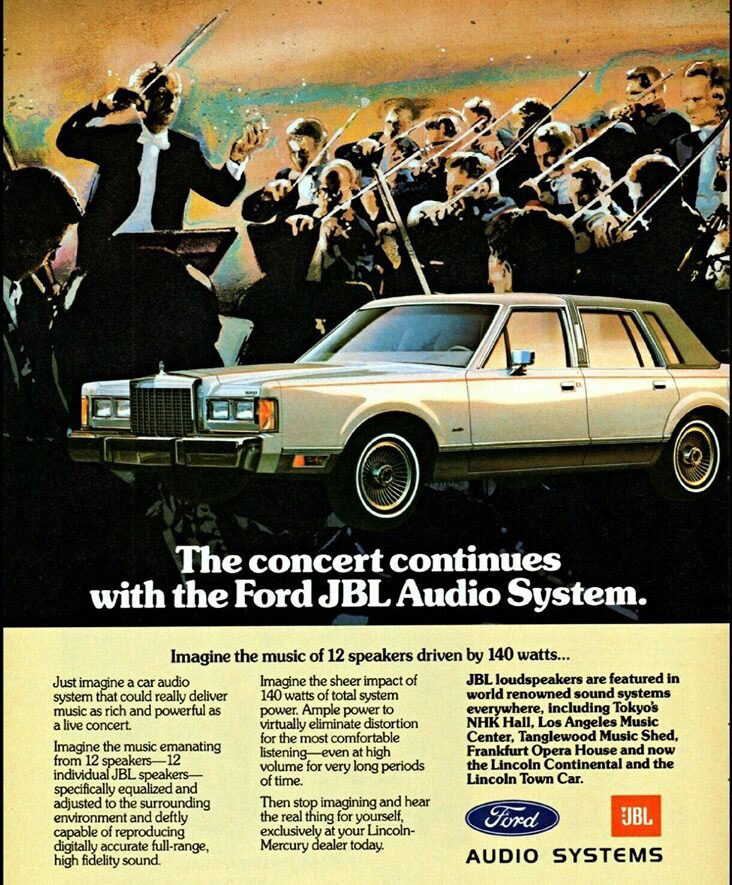
From 1984, JBL discovered the automotive sector. Ford starts with the luxury class model "Lincoln Town Car". A total of 12 drivers were installed, driven by a power amplifier with a maximum output of 140 watts. Currently (2021) Toyota, Kia and Smart are supplied (Photo: JBL)
Since that time, JBL has developed into a permanent audio player in the automotive segment. Among other things, JBL supplied the loudspeaker chassis for Ferrari, today Toyota, Kia and Smart rely on JBL components - see also the numerous LowBeats test with JBL sound. From then on, the combination of heavy-duty drivers with JBL know-how and clever Harman electronics was to have a significant influence on the group; Harman Automotive, which always had (and still has) its research focus in Germany, became a cash cow in the Harman cosmos.
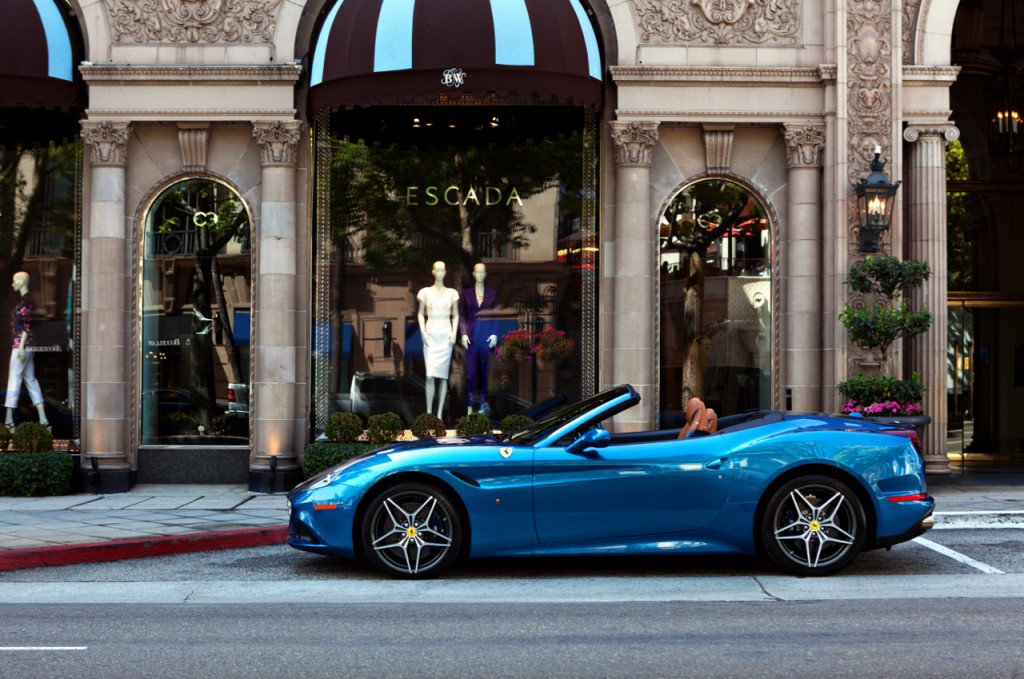
The king of convertibles for audiophiles: Ferrari California T with JBL Pro (Photo: Harman)
But of course you also stay true to your roots. In 1987, the mini speaker "JBL Control One" came onto the market. A box that almost everyone is guaranteed to have heard of, because the two-way loudspeaker in the robust and sealed plastic housing is extremely popular in the catering trade. The Control One was so good in its original version that Alan Parson (who is a sound engineer in his main job at Abbey Road Studios, among other places) once claimed that he could also do great mixes with the Control One. No wonder that the box dwarf is said to have sold well over 1.5 million times in Germany alone. Once again, JBL managed to have the best-selling speaker in its class. Incidentally, the Control One is still available – including as a BT active version.
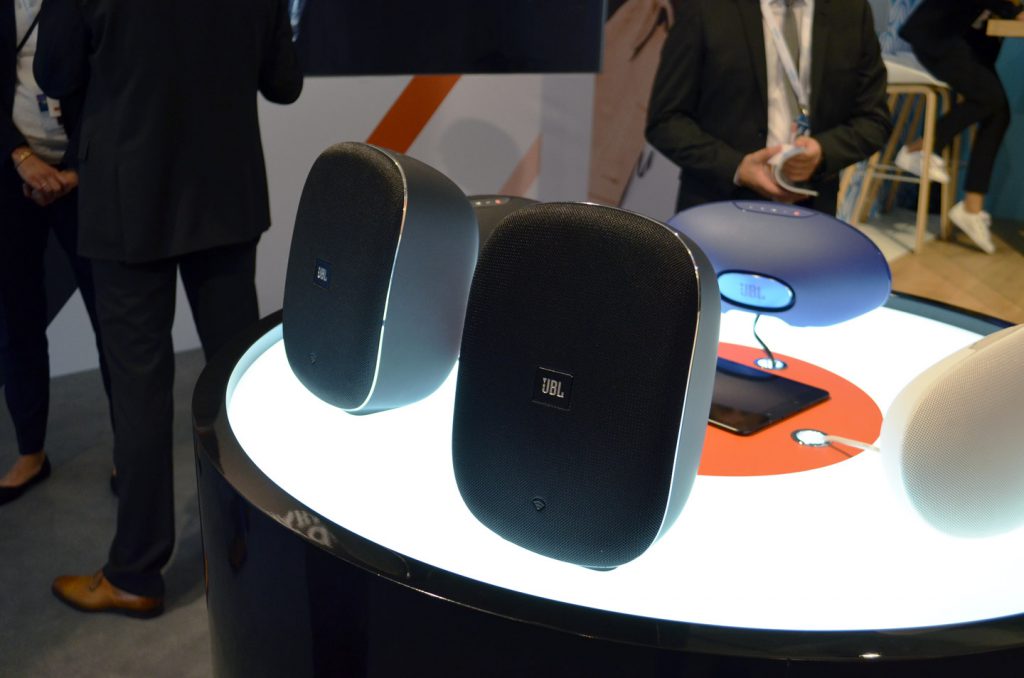
The legendary JBL Control 1 – here in its currently most modern wireless version (Photo: H. Biermann)
JBL is sold in West Germany from 1967 by "Inter-HiFi" in Heilbronn - later "Harman Germany". Over the years, Europe has taken on a whole new meaning, because exports from the USA to the old continent are expensive. From the late 1980s, Harman Germany and the American parent company decide to set up production in Europe. Among other things, the chassis will come from Audax's own factory in France, and the housing will be manufactured by "Harman Consumer Manufacturing A/S" in Ringkøbing/Denmark. Loudspeaker developers are also employed in Heilbronn, who design special boxes for the European market.
For example Berndt Stark. Stark, who would later shape the loudspeakers from Quadral- and Burmester for a long time, was involved in the further development of the JBL Control One (Version G) and is also responsible for the Ti5000 , which came onto the European market in 1994. The Ti5000 was clearly inspired visually by the 250Ti. It was a little smaller, weighed a little less, so it was more “living room-friendly”. At least by German standards. The truncated pyramid design was retained, which was also well received in Europe. One could assume that it was a further evolution of the L250. But not true. The Ti5000 was completely redeveloped in Germany by Berndt Stark.
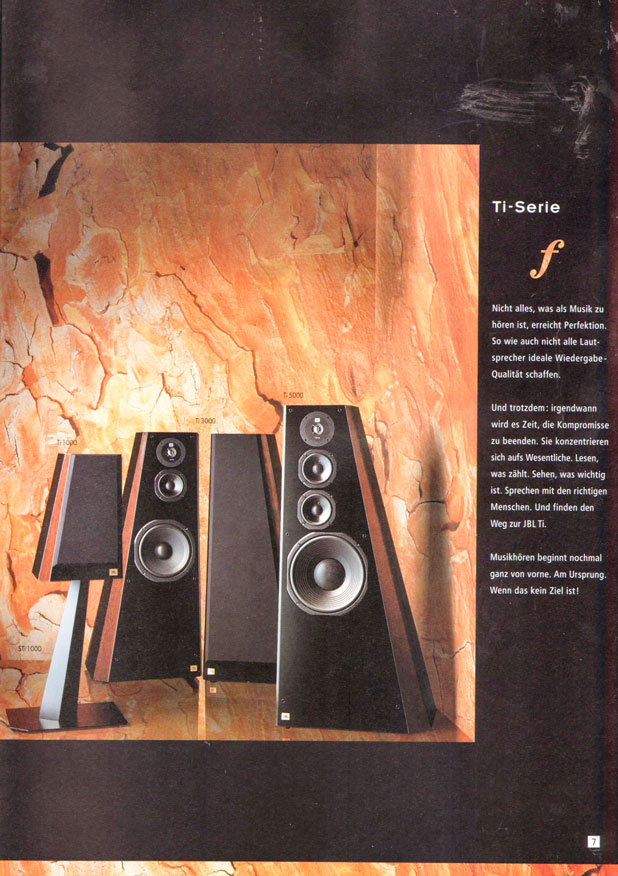
The JBL Ti5000 and her sisters. The Ti5000 was designed specifically for Europe. The housings came from Jutland/Denmark, the drivers from Audax (a Harman subsidiary) in France. It became famous because of its aggressive pricing policy: while a pair initially cost just under 11,000 Deutschmarks, this later went for less than 5,000 Deutschmarks (Photo: JBL)
This Ti5000 had many fans, but also many opponents who feared a departure from the true JBL way. On the other hand, it is true that Berndt Stark appealed to European ears much better than his colleagues at JBL headquarters. And because the Ti series was also completely manufactured in Denmark - as a reminder: at the end of the 90s the Danish boxing industry was probably the most efficient in the world - the prices of the Ti5000 could be drastically reduced. Because of its tempting (and pre-planned) strikethrough pricing, the Ti5000 achieved volumes its predecessors could only dream of and never again at this size and power class - another JBL record.
The then managing director of Harman Germany, Jack Grigg, was responsible for the drastic price reductions. He managed to get the premium loudspeakers to cost only 5,000 marks a pair instead of the previous 11,000 marks. We asked him how this was possible and he answered in the interview:
“ At that time, the Ti5000 cost around 5,400 marks apiece, that is around 11,000 a pair. There were four couples a month on average, from the Ti5000. We had a meeting in Denmark and the European boss asked me: Grigg, what if we lowered the price? What can we sell? Instead of eight pieces a month, we can go to 1000 pieces a year, I replied. Then he started the machines.
The box was then sold with a 50 percent discount. For 2499 marks and of course that really went through the roof and we actually sold 1000 units a year. In addition, we started to supply MediaMarkt and Saturn for the first time. Of course, the dealers then no longer had factor two, the purchase price was 1300, 1400 German marks. But they still had a 35 percent margin. That was also what I was aiming for and I found that to be quite correct. Accordingly, things went very well. This active pricing policy did not only apply to the Ti5000, but to all boxes and thus increased the volume massively. The Ti5000 was an absolute hit afterwards.”
But it is also true that the 5000Ti got a flaw. Just a few months later, the Danish plant in Ringkøbing developed a simple crossover for the iconic 5000Ti - and the JBL managers, who were geared towards maximizing profits, finally banned the complex Stark crossover from the range. Most buyers didn't notice the change. But anyone who heard the difference between the two versions knew immediately that the slimmed-down version didn't stand a chance against the original version by Berndt Stark...
But regardless of the success (JBL and its sister company Infinity accounted for almost 40% of the higher-priced loudspeakers in Germany at the end of the 1990s), JBL met the same fate that befell other manufacturers in the 2000s: the classic hi-fi system, 43 -cm wide electronic components, stacked on top of each other, with two large loudspeaker boxes in a wooden housing, are in less and less demand. In August 2003, the then managing director of Harman Consumer Manufacturing A/S, Torben Hansen, announced the end of the once successful box production in Jutland, where 500 people worked at its peak:
Hansen: “Two years ago, the production of our inexpensive speakers went to our sister factory in Mexico. We had to focus on the more expensive wood-finished products, but unfortunately the volume has dropped significantly in the meantime. In just one year, sales have dropped to almost zero. Everyone is under pressure and the consumption indicators have been pointing downwards for a long time (...). We can't go on. There is a strong shift in the speaker market to other speakers that are now covered in aluminum and plastic. Most of this type of production is now made in the Far East, where quality has greatly improved. In addition, workers only receive about four percent of a Danish wage.”
It was a bit as if the plug for HiFi had been pulled with a lot of wood with this step at JBL. During this time, JBL is increasingly focusing on the professional segment in cinemas or as PA reinforcement at live concerts.
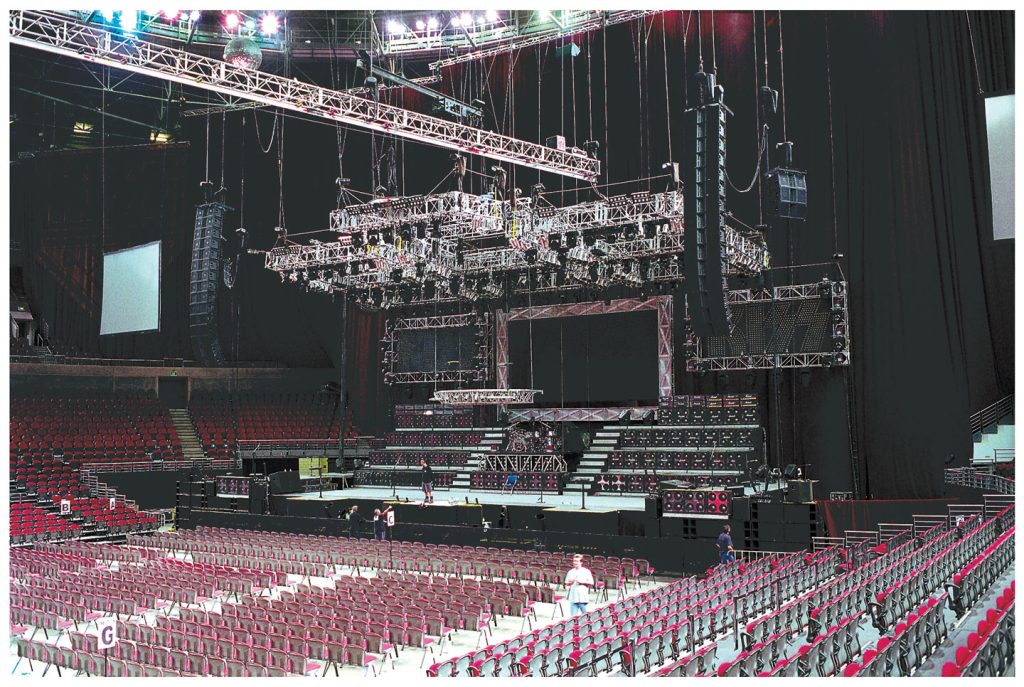
Like almost all sound reinforcement systems, JBL works with box arrays that "illuminate" the audience areas. We see a number of VerTec arrays here on the 2001 KISS tour...
In the years 2007/2008, a kind of change in awareness took place at JBL with regard to audio. Instead of a comparatively small number of large wooden boxes, they wanted to sell many small smart products such as Bluetooth boxes or compact soundbars. The idea came up with the Bluetooth speaker called Flip at the latest. The BT box, which is barely the size of a beer can, is now in its 5th generation ( see test ) and has - once again - broken all sales successes.
The hi-fi friends among the JBL fans will certainly see this development with more than just one crying eye, because in terms of classic loudspeaker hi-fi there are almost only derivatives of existing models - such as the fascinating Everest DD 67000 .
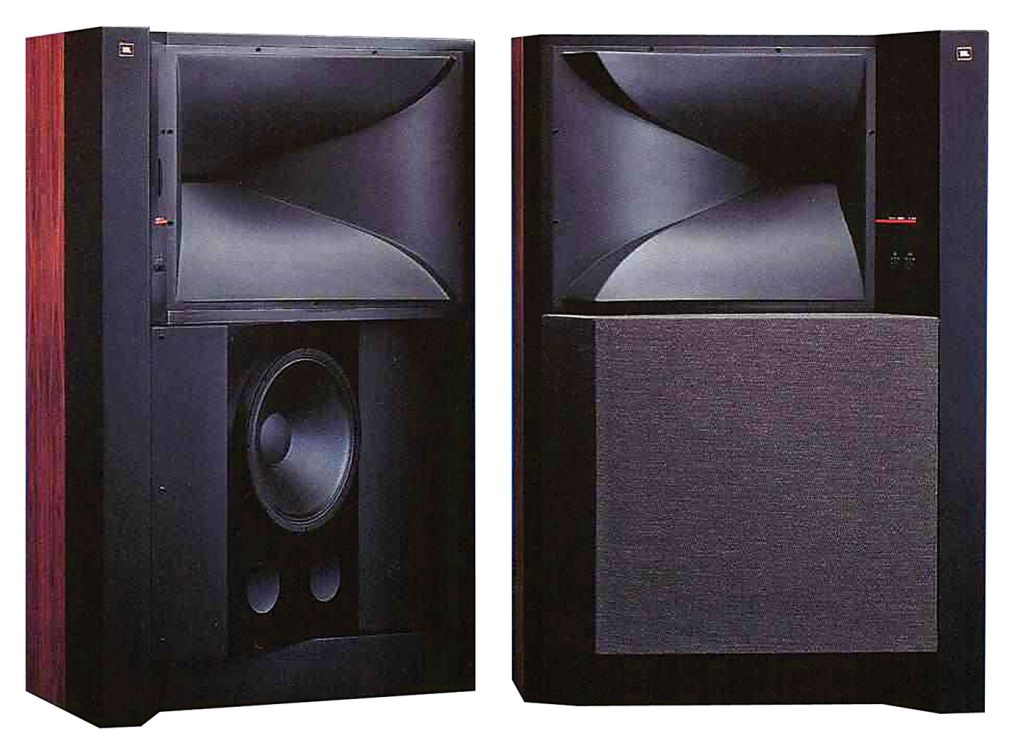
The JBL DD 55000 is undoubtedly the predecessor of the…
But the company strategists seem to have done everything right: whether JBL Flip , Charge , Pulse , Boombox & Co. - JBL sets records in the headphones and Bluetooth speaker area. At the last IFA 2019, JBL can report a record: 100 million mobile loudspeakers were sold worldwide. An insider said: "Even in the successful HiFi years, JBL never turned over more than 180 million euros in Europe. Today, thanks to BT boxes and headphones, there are 1.5 billion.”
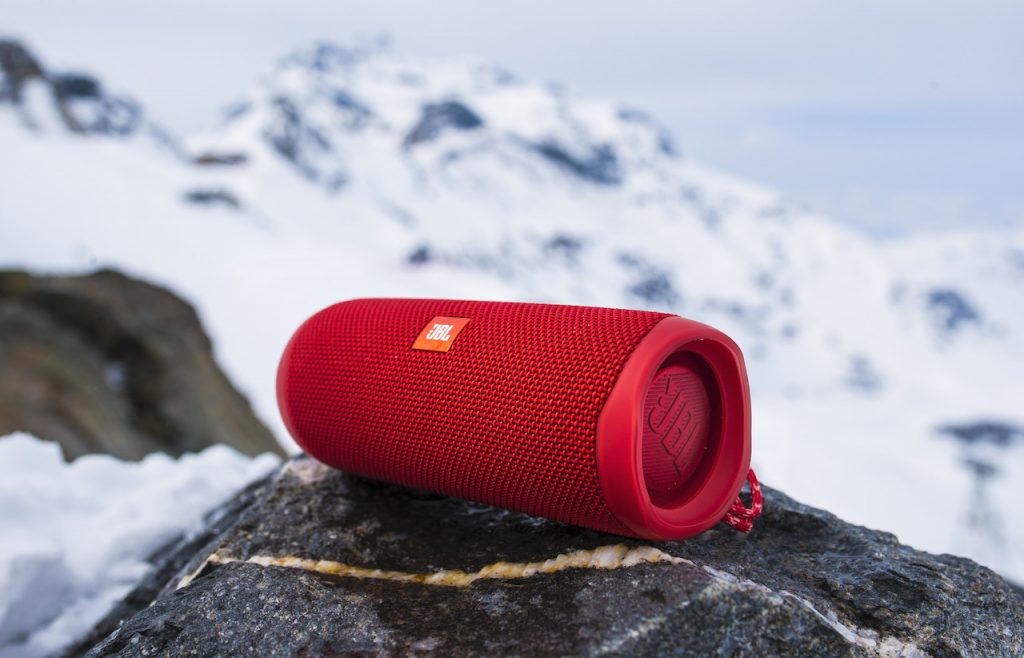
The current JBL Flip 5 is representative of the weatherproof all-rounders that have brought JBL back to the top of the loudspeaker market. Except that the speakers are much smaller now... (Photo: JBL)
This was only possible because JBL was able to calculate its superior driver technology down to the smallest units. The think tank around Dr. Sean Olive , who coached legendary JBL consultant Dr. Flyod Toll inherited. Like Floyd Tool (or Amar Bose) was Dr. Olive is always looking for acoustic explanations for this or that phenomenon. Or for the right solution. Because it is a great skill to conjure up such a volume of sound from a small box like the Flip 5. This may not require 75 years of experience, but it does require a great deal of knowledge about physics and psycho-acoustics.
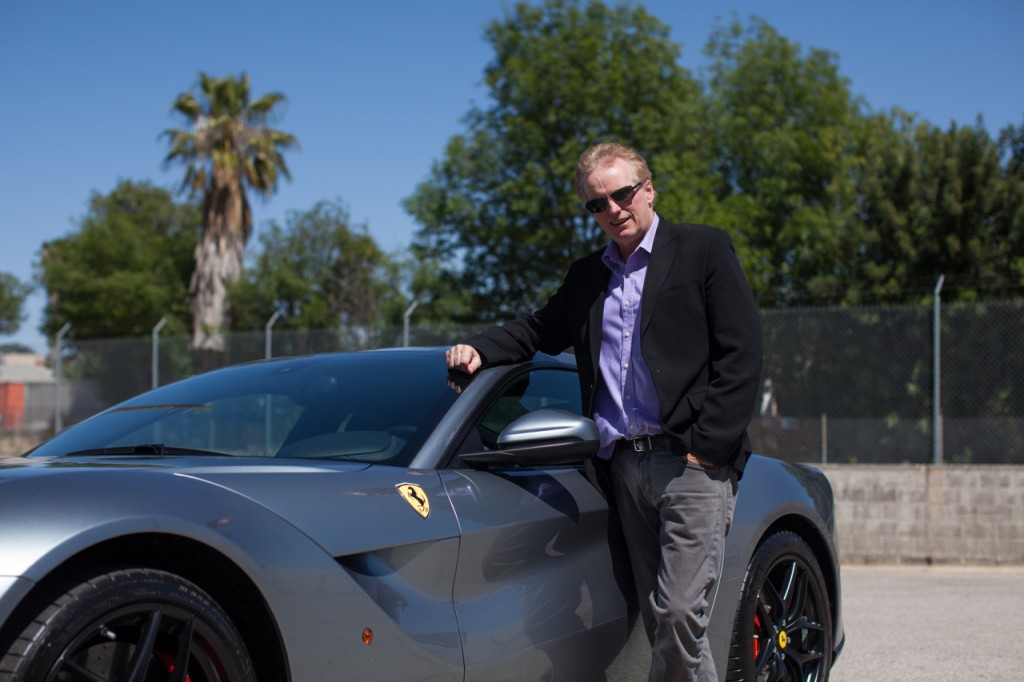
Dr Sean Olive is a luminary when it comes to sound. Here he is leaning against the Ferrari California T, which JBL Pro has equipped with a powerful audio system (Photo: Harman)
75 years of JBL. After so many eventful and ultimately successful years with so many highlights in almost all areas of acoustics, we would have thought that JBL would really let it rip. But wrong: They launched the SA750 integrated amplifier (because JBL is so well known for integrated amplifiers...?) and launched a special version of the L100 (named L100 Classic 75). This isn't even table fireworks and looks more like an alibi. Too bad actually. So at LowBeats we're doing our own little JBL celebration - in the form of a review of the brand new JBL L52 Classic. It connects the old and the new JBL worlds in the best sense of the word: It is comparatively small and therefore has a pretty good volume level – loud & clear!
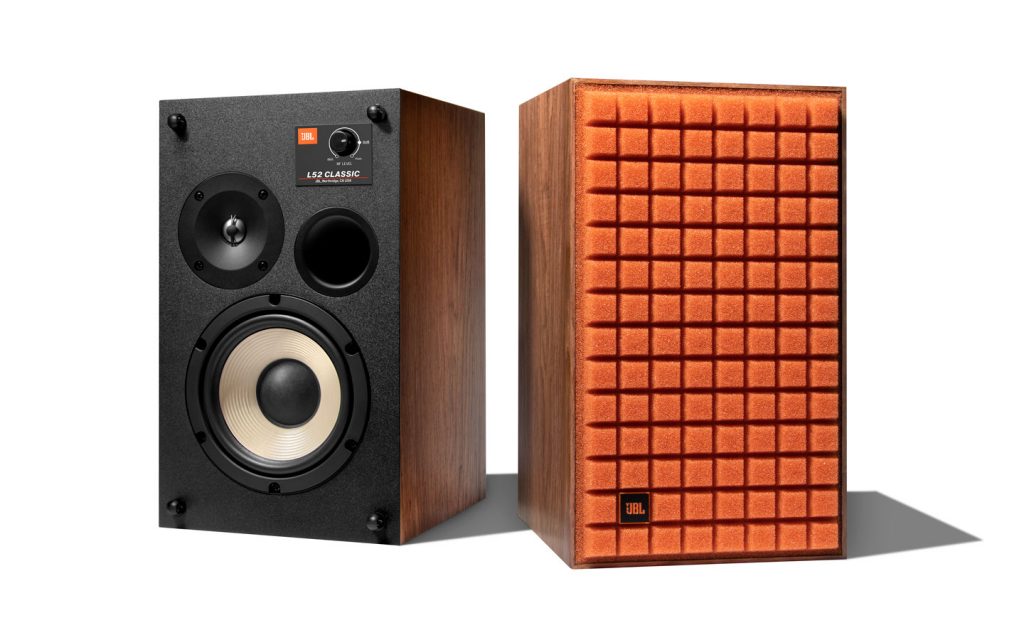
With the L 52, JBL rounds off the high-volume retro series called "Classic": the small 2-way box costs 1,000 euros / pair (Photo: JBL)

Like no other manufacturer, JBL stands for the combination of hi-fi and studio - here the studio monitors 4430 and 4435. LowBeats took a look at 75 years of company and loudspeaker history (Photo: JBL)
75 years of JBL: 75 years of Loud + Clear!
Andrew Weber October 30, 202175 years of JBL: In October 1946, a certain James B. Lansing laid the foundation for a loudspeaker brand that bore only his initials without any glamour. Today, JBL is the largest and best-known speaker brand in the world. LowBeats took an intense, by no means brief, look back...
When James (aka Jim) Bullough Lansing was born on January 14, 1902 in Green Ridge, Illinois, he was not only the ninth child in the family, he also bore the family's name: Martini. It had nothing to do with vermouth (see Martini ) but rather with melancholy – here in the sense of sadness. There was next to nothing there and what was there quickly disappeared. That, too, is America: the boy was born in a backwater town that had existed for little more than 30 years at the time, and which presumably only had the “Green” in its name because the shacks in which the villagers lived were painted green. The people of "Green Ridge" lived off and around a coal mine, which James' father also bent over backwards for.
Big family, meager wages, lots of hunger. This may also explain a little why the ninth offspring (of a total of fourteen siblings) stayed in Litchfield, Illinois with a foster family named "Bullough" (meaning: bull/ox). The pubescent boy must have felt so comfortable in her care that years later he took her name. The fact that he then also gave himself the surname "Lansing" is more due to a fad of the early 20th century in the United States. His name was simply meant to sound "American" and not like his ancestors, Italian immigrants. It didn't do him any harm. Two of his brothers (Bill and George) made it easier for themselves and simply dropped the -i from the surname and were henceforth called Martin.

It is probably the most well-known image of James B. Lansing, who founded today's largest and best-known loudspeaker brand. However, the company did not bring him any blessings (Photo: JBL)
There is no doubt that Jim grew up in a time of technological breakthrough. The telephone, the radio, the automobile became mass products in the United States in the 1910s and 1920s. James' home state, Illinois, also came into focus, because that's where the Lincoln Highway was built from 1913, connecting the east and west coasts and leading through 13 states.
So it's no wonder the boy was infected by the "technology virus". Around the age of 12, he is said to have built a crystal radio receiver and transmitter powerful enough to jam naval communications. Didn't find it that great, because it was located and the transmitter shut down. However, this did not dampen his enthusiasm for technology. James graduated from high school, found a job at the Leland Lincoln dealership in Springfield. People there were very satisfied with him, recognized his talent and paid for attending a car locksmith school in Detroit. It was a time when spare parts for cars were hard to come by, so Jim learned the skills of making parts himself, John Eargle also reports in the book"The JBL History: 60 Years of Audio Innovation ". When James' mother died unexpectedly on November 1, 1924, he decided to go west.

Jim Lansings grew up in a time of technological breakthrough. For example, the first highway in the USA – the Lincoln Highway – crossed his home state of Illinois. The picture shows the Lincoln Highway in the 1920s (Photo: Wikipedia)
No sooner said than done, he landed in Salt Lake City. He was young, he was certainly bubbling with ideas and found a job at the "Felt Auto Parts Company" - a suitable new start to prove and expand his knowledge of automotive and mechanical engineering. You don't have to read between the lines: Jim wasn't a qualified electrical engineer like Paul Wilbur Klipsch and - here an "unfortunately" belongs - also not a resourceful businessman like Frederick Whitney Horn , but a fascinating, talented inventor and autodidact, as we shall find out.
75 years of JBL: the first steps
Author Donald Ritchie, speaking to contemporary witnesses who were still alive at the time, writes in his 2006 chronicle "The History and Legacy of JBL"that at that time Jim was spending his free time at the workbench experimenting with loudspeakers. He made paper cones, which he connected to electromagnetic loudspeaker drives manufactured by Nathaniel Baldwin. Absolutely understandable, because after all, Baldwin is considered the American inventor of the headphones and he was doing well at the time. The cone loudspeakers used by James - not yet Lansing - were a new development at the time and offered the possibility of achieving a much better sound than the well-known horn loudspeakers that were usually used in radios and gramophones. Technical background: Electrodynamic cone loudspeakers have an externally excited magnetic field coil, which is located in an iron core and generates the required constant magnetic field electrically. Essential at the time, because powerful permanent magnets were not available at that time.In 1925 James not only met his future wife, Glenna Peterson, but also Kenneth Decker. James had meanwhile decided to get into the manufacture of loudspeaker chassis and was looking for a partner. Decker, whose family ran a thriving jewelry business, was probably also drawn to the idea, as the two teamed up. Finally, in 1927, they moved to Los Angeles, then the center of radio receiver production. At home they made loudspeakers from folded paper cones and self-wound voice coils. In the same year, Born Martini, he changed his name to James Bullough Lansing and founded the Lansing Manufacturing Company (LMC).

"The Jazz Singer" is considered the first commercial sound film. It was released in cinemas in 1927 and the audience was enthusiastic, the triumph of the sound film unstoppable. And yet there were problems, because the sound quality was not really convincing. This was not only due to the lack of powerful technology, but also to the fact that some of the cinemas were huge at the time: they sometimes held 5,000 spectators (Photo: Wikipedia)
Another event that attracted worldwide attention in 1927 was to determine the later future of Lansing's company: in October the first sound film - " The Jazz Singer " - was released and the audience was enthusiastic. Although the sound reproduction was far from perfect. In fact, the film industry itself did not have its own loudspeaker production capabilities, so Western Electric (WE), a telecommunications industry company (AT&T), took over the part. There was sound for the moving image, but there was no question of "sound". The early WE cinema loudspeakers consisted of a large curved exponential horn, whose frequency response was limited to the range from about 100 Hz to 5000 Hz. Even adding tweeters and woofers was not enough to convince the filmmakers in Hollywood.

Western Electric's WE 15A. Year of manufacture probably 1927
Things got better in 1933. Douglas Shearer, head of the MGM sound department (MGM: Metro-Goldwyn-Mayer, film production), decided to take the development of new loudspeakers into his own hands and to seek external support for this. Lansing and Decker were already producing chassis for cathedral radios with great success, which integrated the loudspeaker into the housing. They had meanwhile reached considerable quantities, supplied a wide range of manufacturers of radio receivers and employed 40 people. A size that was apparently enough to draw attention to itself. Speaking of size: anyone who thinks of today's usual halls with just over 300 seats when hearing the term "cinema" is more than ten times wrong. At that time, a movie theater in the USA could hold 5,000 spectators – mind you, in one hall. And it was quite common back then to go to the cinema twice a week! Nice old pre-television days.

One of those cathedral radios for which Lansing & Ceiling made speakers at the time: here a model from the "Philco" brand from around 1930. It seems like a historical joke that almost 100 years later JBL is again having huge success with single-box devices … (Photo: HiFi Wiki)
Lansing finally got the order to develop cinema loudspeakers together with MGM. The so-called Shearer-Lansing system was implemented within two years . It was a large two-way system consisting of a multi-cell tweeter horn and a W-shaped woofer horn enclosure. After a successful test run in twelve of MGM's own Loews cinemas, 150 units were ordered and installed. A smaller model also came onto the market, the 500-A. It was used for sound reinforcement in projection rooms and dubbing studios - early studio loudspeakers. A segment in which the company, later renamed “JBL”, will also occupy a leading position for many years.
In 1937 Lansing developed the Iconic system. It's a small two-way system with a vented 15-inch woofer and a small-size compression tweeter driving a small multi-cell horn. Frequency response: 30 to 15,000 Hz! No wonder the Iconic system became the most popular monitor speaker of its time and served as the foundation for studio speakers to follow.
It still looks delicious today: The Iconic System already achieved a really high-fidelity frequency response: 30 – 15,000 Hz (Photo: JBL)
LMC also used the great success of the Shearer-MGM connection in other product areas. The company continued to supply systems for the motion picture industry and a variety of early professional sound reinforcement applications. However, the company's success depended on the synergy of its key players - Ken Decker and James Jansing. When Decker died during US Army Air Corps maneuvers in 1939, not only did Lansing's partner die, but also the company's chief financial officer. Already at the beginning of 1941 the consequences are clearly noticeable. Only nineteen employees are still actively working for Lansing Manufacturing Company at this time.
Ultimately, cinemas were probably not enough as the main segment for sales, and the manufacture of loudspeakers for radios was not seriously pursued. Decker could have opened up new markets if he should... A similar fate happened to Altec Service Corporation (Altec is an acronym from the words "All Technical"), a company that specialized in the maintenance of Western Electric sound equipment and the the spare parts ran out because WE had withdrawn from this segment. John Kenneth Hilliard, a senior sound engineer at MGM and instrumental in the development of the Shearer-Lansing system, eventually suggested that the company heads meet. The goal: to be more efficient and competitive together. As a result, Altec Service Corporation purchased Lansing Manufacturing Corporation on December 4, 1941 for $50,000 (equivalent to around $1 million in 2021). Jim Lansing signed a five-year contract with the new company and was named vice president of engineering. The "Altec Lansing Corporation" was formed.

For the first time, the Shearer Lansing system brought good sound to the back row of cinemas. It was released in 1935 and installed in MGM's "Loews" movie theaters. The two-way system consisted of a multi-cell tweeter and a W-shaped woofer horn housing (Photo: JBL)
Three days after the ALC was founded, Pearl Harbor was attacked, with consequences for the whole country, including Altec Lansing. Products important to the war had priority. The American President Roosevelt demanded the uninterrupted production of armaments. Later, US citizens were even called upon to donate all their copper, aluminum and other materials as war donations. Altec Lansing supplied the government with transformers and other electrical equipment. The research on new speaker chassis, however, continued uninterrupted, because business was good despite everything.
The cooperation with the military was also to bear unexpected fruit: in 1943 Altec Lansing was commissioned to work on a radar project for military aircraft. This gave James Lansing access to a new type of magnetic material - AlNiCo.
AlNiCo was a quantum leap for driver construction, it was to revolutionize speaker construction and dominate for decades. Using AlNiCo V, Jim Lansing developed a new version of a large format permanent magnet compression driver . He also perfected the hydraulic forming of aluminum cones and the voice coils were wound from aluminum wire using a new process. The result was the Altec Lansing 288, which was to remain in the range for decades in all its evolutionary stages.
Although financially successful, Jim Lansing only stayed with Altec Lansing Corporation for five years. "I'm just a name for them," he is said to have said and left the company after his contract expired - allegedly to grow avocados and lemons. However, anyone who thought Lansing would have been content with that had dealt in lemons themselves. Lansing Sound Incorporated was entered in the commercial register on October 1, 1946. This naming annoyed Altec Lansing, and shortly thereafter Lansing renamed the company James B. Lansing Sound Incorporated, or JBL for short.
1946: the founding of JBL
Between 1946 and 1947, Lansing worked incredibly hard and developed a number of new loudspeakers - also for the music lover's market at home, which was steadily increasing in importance. The D-1000 system , for example, was aimed precisely at this target group and the two-way box was JBL's first home loudspeaker.
Jim Lansing's first speaker for the music lover at home appeared in 1948, the D-1000, a two-way bass reflex system. It is advertised with the following words: "The D-1000 Signature loudspeaker is a complete two-way loudspeaker system housed in a practical housing (Photo: JBL)
Demand grew, JBL had to grow, production was bursting at the seams. This is where William Thomas from Marquardt Aviation came into play for the first time. He agreed with Lansing on a share of ten percent of the net sales, for which Lansing provided him with production facilities and employees. Marquardt manufactured engines for the United States Army Air Forces, so there was no end to the space. And money. Money that Lansing could use for its production.
Unfortunately, that didn't help much either. Because while Marquardt Aviation grew, Lansing got more and more indebted. In desperation, he tried to sell the company to Roy Marquardt, but he didn't put much stock in loudspeaker manufacture. Finally, Marquardt Aviation was taken over, but the buyer was also not interested in the James B. Lansing Sound. In the end, Lansing only held 30 percent of the company because of his debt. Roy Marquardt decided that William Thomas should run the company. Although the bright developer spirit had always given everything, he probably lacked the strength for a new beginning. James Bullough Lansing took his own life on September 29, 1949. He was only 47 years old.
Desire for loudspeakers
After Lansing's death, William Thomas took over the management. He bought the last of Glenna Lansing's company shares and was now the sole owner of JBL. A big challenge: Lansing was no stranger, his death could have quickly meant the end of the Californian speaker manufacturer, the company bore his name. However, William Thomas had a number of qualifications that cast JBL's future in a good light. At the top is that he had more than just a financial interest in JBL. If he had only cared about money, he could have stayed at Marquardt Aviation. But the studied physicist was interested in loudspeakers.This was no coincidence, as William had long been working on the soundproofing of aircraft engines and enjoyed researching acoustics. His commercial experience, which poor Lansing repeatedly failed, was undoubtedly helpful. So William Thomas quickly drew up a three-year plan to reduce operating costs while increasing sales. Through aggressive marketing and streamlining of production, he achieved this by the target year, and annual sales climbed from $60,000 to $200,000 in 1952. Profits were meager, but William Thomas had new ideas long ago.
He recognized the growing need for hi-fi loudspeakers and concentrated the offer on this segment. His goal: to establish JBL as the outstanding hi-fi brand. To do this, the bride had to be prettied up, which means that the products shouldn't look like household appliances or do-it-yourself products, but stylish. In 1950, William Thomas hired the industrial designer Alvin Lustig for this purpose. merry knew that aesthetics could influence the purchase decision just as much as technical quality. Connoisseurs certainly think of the German hi-fi company BRAUN, which also successfully implemented this concept from 1956. Works by Alvin Lustig are the C34 , C35 Fairfield , C36 Viscount , C37 Rhodes ,C38 Baron and the C40 Harkness . Boxes that are still extremely popular among collectors today.

At the beginning of the 1950s, the new owner of JBL, William Thomas, focused on design for the first time. He has the well-known industrial designer Alvin Lustig create a product catalog for chassis and boxes. He also entrusts the design of housings to Lustig (Photo: JBL)
Now you have to have a very special taste to locate The Hartsfield as a "design box". It was the JBL alternative to Paul Klipsch's Klipschorn. And unlike the Klipschorn, which still exists today, the JBL was a 2-way construction - which in the case of a corner horn is only the second best idea in terms of sound. The Klipschorn still exists today (version VI), The Hartsfield is only highly valued by collectors...

1954 JBL's Hartsfield comes onto the market. A corner horn that is more than clearly inspired by the Klipschorn, but is considered an independent construction due to the technically superior drivers (Photo: JBL)
And so the gap that James Lansing left as a genius designer became more and more obvious. Although William Thomas also took on some engineering tasks, he did not match Lansing's creative power. So Thomas brought the developer Bart Nicholas Locanthi into the team. A graduate of the California Institute of Science, Locanthi earned an excellent reputation in the audio industry well into the 1980s. For example, Locanthi designed the 1217-1290 horn for JBL's 175 driver, which is believed to be the first commercial example of this type of radiator. A development that formed the core technology for JBL horn products over the next 30 years.

By 1955, William Thomas had finally managed to increase JBL's sales to $1 million. In the same year, the JBL initials were introduced as a logo for the first time. (Photo: JBL)
JBL took another big step in 1957 when the stereo record appeared. William Thomas wanted to achieve supremacy in home audio with a loudspeaker milestone. This is how the Paragon D44000 came about ( here is a small impression from the Youtube world) and the plan worked. The 340 kg Paragon - a full-fledged three-way horn with a real bass horn and pressure chamber drivers for the middle and high frequency range - remained in the program for 26 years. It was displayed and admired at international exhibitions such as the Expo 1958 in Brussels and was readily bought by the rich and famous. At the time, only they could afford it. The Paragon cost $1830 in its introductory year, which equates to about $18,000 in 2021. In total, JBL probably produced around 1000 copies by 1983. In terms of marketing, the Paragon was a mega success, and despite the high price, it was hardly worth it for JBL financially.

In 1957, JBL surprised everyone with the Paragon, a full-blown three-way horn weighing 340 kg (sic!) with a real bass horn and pressure chamber drivers for the midrange and high-frequency range in just one housing. The elegant case design of the JBL Paragon still enchants today...
At the beginning of the 1960s, it also became apparent that large loudspeakers would be less in demand in the home. The expansive music furniture soon gave way to smaller and medium-sized systems that still had good bass reproduction. The traditional Lansing drivers worked best in large enclosures, and their high efficiency was perfect in the days when amplifiers could hardly exceed 30 watts. The hi-fi industry had caught up, higher power amplifiers that took up less space prompted the development of a new generation of cone loudspeakers. Up until 1963, under Bart Locanthi's direction, new drivers of the so-called " Linear Efficiency " were created” series, abbreviated as “LE”. They stood for high linearity at high levels. With the new drivers, compact floorstanding and shelf speakers were now possible.
Parallel to its commitment to the hi-fi sector, JBL has always stepped on the gas in the professional segment. Leo Fender, the legendary manufacturer of musical equipment, relied on the D130 for its guitar amplifiers with built-in speakers .
A Closer Look at the D130: JBL's D130 was a stand-alone loudspeaker that the company began producing in 1948. Although there have been numerous revisions and updates, it is still part of the range today and carries the model designation E130 . An E130 is not a lightweight, it weighs ten kilograms. The D130 was originally designed as a pure woofer, but with the expansion of the frequency range it also became very popular as a mid-woofer.

The D130 was one of the first loudspeakers to feature an aluminum dust cap - as opposed to the fabric dust caps found on its competitors. A cast aluminum frame on the D 130 supports the 15-inch cone, and a rubber seal surrounds the rim to prevent dust from entering the voice coil (Photo: JBL)
The voice coil of the D130 was another innovation: it was 4 inches wide, and while that size is common today, it was revolutionary at the time. Lansing used a flat metal ribbon instead of a wound fine wire to create a coil with a size-to-performance ratio never seen before. The design made more efficient use of the natural shape of the magnetic field, allowing more power to be generated with less material. This design also dissipated heat and energy more evenly, reducing the risk of breakage and increasing cone life.
Although JBL manufactured the D130 largely unchanged throughout its production history, an alternative version was produced specifically for use in guitar amps. The speaker was designated the D130F and was specially made at Leo Fender's request. The D130F was identical to the D130 but had a 12 inch cone instead of the usual 15 inch.

The guitar specialist Fender also quickly understood that the basses from JBL were simply better than those of the competition (Photo: JBL)
The professional market remained a constant at JBL, not only for the stage, but also for mixing as monitor loudspeakers in the recording studio. JBL was therefore always keen to engage in dialogue with music creators, so it is not surprising that one of JBL's most famous loudspeakers, at the suggestion of the then well-known sound engineer Bob Finewas born – the 4310 monitor. Fine required eight compact loudspeakers for the new eight-track recording process, which he wanted to place in the control room above the window to the recording room. All the boxes he had available were too big, he turned to JBL and the 4310 soon became the de facto standard for near-field monitoring - even if playback with one speaker per track turned out to be impractical. We will encounter the 4310 and its derivatives again.

The JBL 4310 was developed for the studio, but also enjoyed a high reputation among ambitious hi-fi fans (Photo: JBL)
For those who enjoy the original, by the way: Kenrick-Sound , based in Tokyo/Japan, has specialized in loudspeakers from the 4310 series and later from JBL. Restored and modified chassis are used in historical as well as in newly built boxes. However, saving is advisable: The systems are sold for up to 30,000 euros and more without any problems.
In 1969 the William Thomas era came to an end. Under his leadership, JBL had blossomed into a globally recognized loudspeaker manufacturer in the domestic as well as in the professional segment. In the same year, the legendary Woodstock Festival only used drivers from Altec-Lansing and JBL . A belated tribute to the incredible work of James Bullough Lansing and the companies that grew out of it. He would have liked it. Certainly also the results that JBL achieved: When William Thomas handed over to Sidney Harman in 1969, he had increased annual sales to around nine million dollars - today (2021) that would be the equivalent of around 68 million US dollars.

It wasn't just the sound that moved the world: The 1969 Woodstock Festival was professionally equipped with JBL and took place on the pastures of a dairy farmer near Bethel in New York State (Photo: Wikipedia)
The Harman years
JBL's next owner, Sidney Harman (born 1918), didn't come from anywhere, quite the opposite. He was a pioneer in the hi-fi industry, with ample experience in the development of hi-fi products. In 1954, together with the engineer Bernhard Kardon, he brought the first receiver onto the market, the Festival D-1000 .
1969 JBL is taken over by Sidney Harman. With a two-year break, he will lead the company to further major successes until 2007. Incidentally, he is leaning casually here on a 250Ti (Photo: JBL)
The native Canadian not only knew about electronics, but was also a clever marketing strategist. One of his first official acts: to introduce the gratifyingly successful 4310 studio monitors as the L100 in the home audio sector. Harman pressed the tube: The JBL L100 Century was already presented at the CES 1970 in Chicago. The 4310 and L100 were technically almost the same, which JBL didn't even try to hide, they boasted about the numerous uses of the boxes in the recording studio. JBL used a single sentence as a message to market the speakers: "You can hear music in your home the way the sound engineers heard it when they created it." The box sold like hot cakes.

One of Sidney Harman's first decisions quickly turned out to be brilliant: The Box 4310, which was very successful in the professional sector, was marketed in the home segment as the L100 from 1970. The advertising campaign shown is a reference to Clark Kent aka Superman. Matching the pop culture of the 1960s and 1970s, the colors of the speaker covers on the L100 were also available (Photo: JBL)
The original L100s weren't just JBL's best-selling hi-fi speakers of those years. "There's also evidence that this product was actually the best-selling speaker system of the decade," said Jim Garrett , Senior Director, Product Strategy and Planning, Luxury Audio at Harman on JBL's 75th Anniversary (2021). Because of the resounding success, Harman introduced the cheaper L200 and L300 models in the hi-fi sector, while the 4320 and 4333 models became larger and more expensive in the professional segment.
But there have also been setbacks. At the end of the 1970s, the global supply of cobalt almost came to a standstill. Suddenly it was hardly possible to produce AlNiCo V anymore. While there were replacements on the market in the form of ferrite magnets, these could not readily be used with JBL's existing speaker models.
As a result, new drivers had to be developed, which also led to new products. But this is where the enormous knowledge in the development department showed itself: Although today only very few drivers are equipped with the (soundingly superior) AlNiCo magnets, the woofers, mid-range drivers and tweeters from JBL are still considered towering by many other brands think. Especially in terms of level stability and low distortion, there is hardly anything better today. The motto "Loud & Clear" is based on this high understanding of driver technology.
And that also happened within 75 years of JBL: In 1977, Sidney Harman sold JBL to "Beatrice", a conglomerate that also traded in food. The reason was that Harman accepted an office in the Carter administration and was required by law to divest himself of company shares. In 1979, Sidney Harman resigned from government and bought back JBL and other brands. Jack Grigg, long-time Infinity sales manager and Harman Germany CEO, said in an interview: "Originally, he had already sold JBL to Beatrice Foods, who had no idea about electronics. Later he bought JBL back very cheaply. Sidney Harman was a really smart dog.”
A new milestone appears in the Sidney-Harman period in 1982: the L 250, with which he poses in the picture above. With the L series, of which the 250Ti was certainly the most magnificent form, JBL began to think specifically in terms of hi-fi. Because such a half-pyramid shape was of course useless in the studio. The L250 was designed by Greg Timbers who has worked for JBL since 1972. When he started, he was Ed May - who helped to realize the 4310 and the "LE" series - placed aside. He could hardly find a better “teacher”. The L250 and especially the further development with titanium dome - 250Ti - are considered by fans of the brand to be the best loudspeakers that JBL has ever built.
Til today. Doug Warner from Warner Designs was responsible for the design, and he also helped determine the look of the L100. He designed the housing of the bass reflex system as a truncated pyramid with only two vertical side walls. There were countless veneer finishes available, but this was mainly because customers in the US wanted the boxes to match their living room decor. The first version of the L250 featured the LE5 midrange driver and an aluminum-coated phenolic resin dome.

The JBL L250 was a milestone for the brand towards affordable living room hi-fi - but of course with JBL's own dynamics (Photo: JBL)
In Germany, the further improved successor 250Ti (with a titanium tweeter) appeared for the first time in 1985 and was enthusiastically received by music lovers and professional circles alike. Even if their list price of 12,000 DM at the time required some thrift. But the list prices at JBL Germany were soon over, as we will find out later.
In principle, the 1980s were perhaps the most fruitful decade for hi-fi. In addition to the 250Ti, such fascinating models as those of the XPL series or the K2 S-9500 were created - which still exist today in slight modifications

The JBL XPL 160 from 1989. Its special feature was the huge (75 mm) titanium midrange dome (Photo: JBL)
Also in the 1980s (more precisely: 1984) JBL enters a new segment that should turn out to be extremely beneficial in the decades to come. High-quality loudspeakers, cassette radios and amplifiers are supplied ex works for passenger cars. Starting with the equipment for the Lincoln Town Car, a luxury vehicle in the United States. The system was 40 watts more powerful than the competing Bose system in General Motors cars and consisted of a gray JBL car stereo with cassette and two- and three-way JBL speakers. The powerful 6×9 inch woofers in the parcel shelf sported a Ford JBL badge on the metal speaker grille so everyone could tell that the driver cared about good sound.

From 1984, JBL discovered the automotive sector. Ford starts with the luxury class model "Lincoln Town Car". A total of 12 drivers were installed, driven by a power amplifier with a maximum output of 140 watts. Currently (2021) Toyota, Kia and Smart are supplied (Photo: JBL)
Since that time, JBL has developed into a permanent audio player in the automotive segment. Among other things, JBL supplied the loudspeaker chassis for Ferrari, today Toyota, Kia and Smart rely on JBL components - see also the numerous LowBeats test with JBL sound. From then on, the combination of heavy-duty drivers with JBL know-how and clever Harman electronics was to have a significant influence on the group; Harman Automotive, which always had (and still has) its research focus in Germany, became a cash cow in the Harman cosmos.

The king of convertibles for audiophiles: Ferrari California T with JBL Pro (Photo: Harman)
But of course you also stay true to your roots. In 1987, the mini speaker "JBL Control One" came onto the market. A box that almost everyone is guaranteed to have heard of, because the two-way loudspeaker in the robust and sealed plastic housing is extremely popular in the catering trade. The Control One was so good in its original version that Alan Parson (who is a sound engineer in his main job at Abbey Road Studios, among other places) once claimed that he could also do great mixes with the Control One. No wonder that the box dwarf is said to have sold well over 1.5 million times in Germany alone. Once again, JBL managed to have the best-selling speaker in its class. Incidentally, the Control One is still available – including as a BT active version.

The legendary JBL Control 1 – here in its currently most modern wireless version (Photo: H. Biermann)
JBL is sold in West Germany from 1967 by "Inter-HiFi" in Heilbronn - later "Harman Germany". Over the years, Europe has taken on a whole new meaning, because exports from the USA to the old continent are expensive. From the late 1980s, Harman Germany and the American parent company decide to set up production in Europe. Among other things, the chassis will come from Audax's own factory in France, and the housing will be manufactured by "Harman Consumer Manufacturing A/S" in Ringkøbing/Denmark. Loudspeaker developers are also employed in Heilbronn, who design special boxes for the European market.
For example Berndt Stark. Stark, who would later shape the loudspeakers from Quadral- and Burmester for a long time, was involved in the further development of the JBL Control One (Version G) and is also responsible for the Ti5000 , which came onto the European market in 1994. The Ti5000 was clearly inspired visually by the 250Ti. It was a little smaller, weighed a little less, so it was more “living room-friendly”. At least by German standards. The truncated pyramid design was retained, which was also well received in Europe. One could assume that it was a further evolution of the L250. But not true. The Ti5000 was completely redeveloped in Germany by Berndt Stark.

The JBL Ti5000 and her sisters. The Ti5000 was designed specifically for Europe. The housings came from Jutland/Denmark, the drivers from Audax (a Harman subsidiary) in France. It became famous because of its aggressive pricing policy: while a pair initially cost just under 11,000 Deutschmarks, this later went for less than 5,000 Deutschmarks (Photo: JBL)
This Ti5000 had many fans, but also many opponents who feared a departure from the true JBL way. On the other hand, it is true that Berndt Stark appealed to European ears much better than his colleagues at JBL headquarters. And because the Ti series was also completely manufactured in Denmark - as a reminder: at the end of the 90s the Danish boxing industry was probably the most efficient in the world - the prices of the Ti5000 could be drastically reduced. Because of its tempting (and pre-planned) strikethrough pricing, the Ti5000 achieved volumes its predecessors could only dream of and never again at this size and power class - another JBL record.
The then managing director of Harman Germany, Jack Grigg, was responsible for the drastic price reductions. He managed to get the premium loudspeakers to cost only 5,000 marks a pair instead of the previous 11,000 marks. We asked him how this was possible and he answered in the interview:
“ At that time, the Ti5000 cost around 5,400 marks apiece, that is around 11,000 a pair. There were four couples a month on average, from the Ti5000. We had a meeting in Denmark and the European boss asked me: Grigg, what if we lowered the price? What can we sell? Instead of eight pieces a month, we can go to 1000 pieces a year, I replied. Then he started the machines.
The box was then sold with a 50 percent discount. For 2499 marks and of course that really went through the roof and we actually sold 1000 units a year. In addition, we started to supply MediaMarkt and Saturn for the first time. Of course, the dealers then no longer had factor two, the purchase price was 1300, 1400 German marks. But they still had a 35 percent margin. That was also what I was aiming for and I found that to be quite correct. Accordingly, things went very well. This active pricing policy did not only apply to the Ti5000, but to all boxes and thus increased the volume massively. The Ti5000 was an absolute hit afterwards.”
But it is also true that the 5000Ti got a flaw. Just a few months later, the Danish plant in Ringkøbing developed a simple crossover for the iconic 5000Ti - and the JBL managers, who were geared towards maximizing profits, finally banned the complex Stark crossover from the range. Most buyers didn't notice the change. But anyone who heard the difference between the two versions knew immediately that the slimmed-down version didn't stand a chance against the original version by Berndt Stark...
But regardless of the success (JBL and its sister company Infinity accounted for almost 40% of the higher-priced loudspeakers in Germany at the end of the 1990s), JBL met the same fate that befell other manufacturers in the 2000s: the classic hi-fi system, 43 -cm wide electronic components, stacked on top of each other, with two large loudspeaker boxes in a wooden housing, are in less and less demand. In August 2003, the then managing director of Harman Consumer Manufacturing A/S, Torben Hansen, announced the end of the once successful box production in Jutland, where 500 people worked at its peak:
Hansen: “Two years ago, the production of our inexpensive speakers went to our sister factory in Mexico. We had to focus on the more expensive wood-finished products, but unfortunately the volume has dropped significantly in the meantime. In just one year, sales have dropped to almost zero. Everyone is under pressure and the consumption indicators have been pointing downwards for a long time (...). We can't go on. There is a strong shift in the speaker market to other speakers that are now covered in aluminum and plastic. Most of this type of production is now made in the Far East, where quality has greatly improved. In addition, workers only receive about four percent of a Danish wage.”
It was a bit as if the plug for HiFi had been pulled with a lot of wood with this step at JBL. During this time, JBL is increasingly focusing on the professional segment in cinemas or as PA reinforcement at live concerts.

Like almost all sound reinforcement systems, JBL works with box arrays that "illuminate" the audience areas. We see a number of VerTec arrays here on the 2001 KISS tour...
75 years of JBL: the modern age
The introduction of MP3 and the iPod make music more mobile. More mobile than a Walkman could ever be. Music is downloaded directly from the Internet and stored on the iPod and derivatives in the 2000s. Soon thereafter, cables for playback are no longer absolutely necessary, streaming is via Bluetooth.In the years 2007/2008, a kind of change in awareness took place at JBL with regard to audio. Instead of a comparatively small number of large wooden boxes, they wanted to sell many small smart products such as Bluetooth boxes or compact soundbars. The idea came up with the Bluetooth speaker called Flip at the latest. The BT box, which is barely the size of a beer can, is now in its 5th generation ( see test ) and has - once again - broken all sales successes.
The hi-fi friends among the JBL fans will certainly see this development with more than just one crying eye, because in terms of classic loudspeaker hi-fi there are almost only derivatives of existing models - such as the fascinating Everest DD 67000 .

The JBL DD 55000 is undoubtedly the predecessor of the…
But the company strategists seem to have done everything right: whether JBL Flip , Charge , Pulse , Boombox & Co. - JBL sets records in the headphones and Bluetooth speaker area. At the last IFA 2019, JBL can report a record: 100 million mobile loudspeakers were sold worldwide. An insider said: "Even in the successful HiFi years, JBL never turned over more than 180 million euros in Europe. Today, thanks to BT boxes and headphones, there are 1.5 billion.”

The current JBL Flip 5 is representative of the weatherproof all-rounders that have brought JBL back to the top of the loudspeaker market. Except that the speakers are much smaller now... (Photo: JBL)
This was only possible because JBL was able to calculate its superior driver technology down to the smallest units. The think tank around Dr. Sean Olive , who coached legendary JBL consultant Dr. Flyod Toll inherited. Like Floyd Tool (or Amar Bose) was Dr. Olive is always looking for acoustic explanations for this or that phenomenon. Or for the right solution. Because it is a great skill to conjure up such a volume of sound from a small box like the Flip 5. This may not require 75 years of experience, but it does require a great deal of knowledge about physics and psycho-acoustics.

Dr Sean Olive is a luminary when it comes to sound. Here he is leaning against the Ferrari California T, which JBL Pro has equipped with a powerful audio system (Photo: Harman)
75 years of JBL. After so many eventful and ultimately successful years with so many highlights in almost all areas of acoustics, we would have thought that JBL would really let it rip. But wrong: They launched the SA750 integrated amplifier (because JBL is so well known for integrated amplifiers...?) and launched a special version of the L100 (named L100 Classic 75). This isn't even table fireworks and looks more like an alibi. Too bad actually. So at LowBeats we're doing our own little JBL celebration - in the form of a review of the brand new JBL L52 Classic. It connects the old and the new JBL worlds in the best sense of the word: It is comparatively small and therefore has a pretty good volume level – loud & clear!

With the L 52, JBL rounds off the high-volume retro series called "Classic": the small 2-way box costs 1,000 euros / pair (Photo: JBL)



